|
|
70-year-old Coast Redwood
at Seabeck WAFinding Good Redwood Habitat
in Coastal Pacific Northwest
Background information and suggestions by CONNIE BARLOW to support
"1000 REDWOODS Project"
underway in the Pacific Northwest
restructured as PropagationNation in 2022Led by by a team consisting of
Bob Barnes, Ralph Munro, Dave Pearsall and Philip StielstraContact: [email protected]
1. Characteristics of Good Redwood Habitat(All plant photos are by Connie Barlow.)
COAST REDWOOD can tolerate neither seasonally dry soils nor tempestuous winds. Boggy conditions and poor soil are inappropriate, too. Whether you are planting in full sun or partial shade, Coast Redwood requires:• Protection from gale-force winds.Puget Sound ("Salish Sea") and continuing into Canada along the Inside Passage between Vancouver Island and the mainland offer a tremendous amount of inner coastal shoreline, often with strong elevational gain and even mountains very nearby. As with the Coast Redwood zone of northern California, these cold marine waters often contribute fog that offsets the impacts of summer drought.• Access to subsurface water flowing from upslope and/or dependable fog to cope with summer drought.
What a grand destination for this tallest of all trees,
in this sad time of too rapid climate warming and coastal drying!
It is up to we humans to make it so.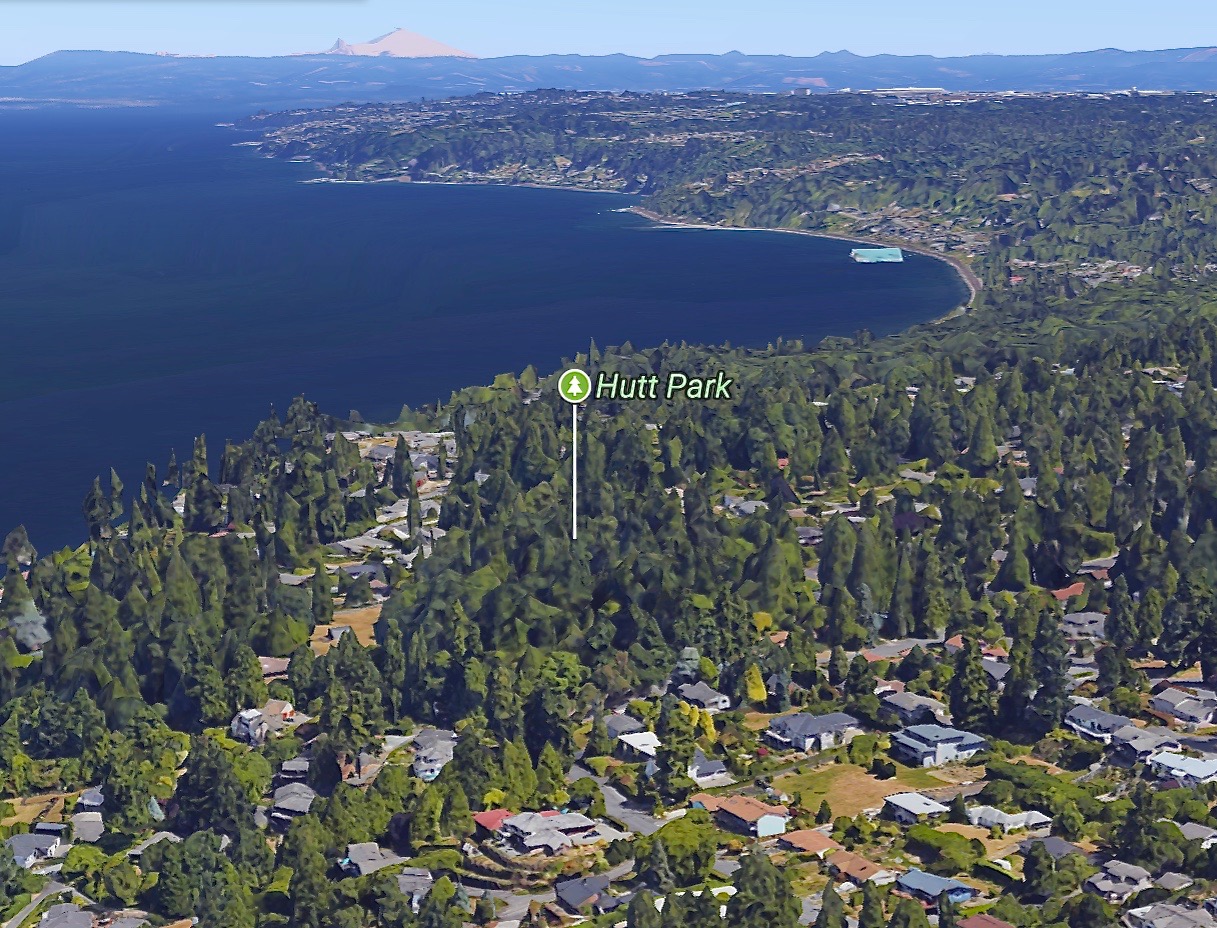
• PROTECTION FROM STRONG WINDS. Being close to cold marine waters can help maximize summer fog conditions, but gale-force winds will blow the tops off redwoods that rise above their neighboring Douglas-fir. The images above show these conditions at Hutt Park.ABOVE LEFT: Hutt Park was originally an estate north of Seattle that then became a regrowth forest park. Two Coast Redwoods had been planted on the estate, and they quickly rose above the neighboring Douglas-fir and Western Redcedar. Because this park is along the eastern shore of Puget Sound, it is exposed to gale-force winds. (Mount Baker is the white mountain in the distance. This image is taken from Google Maps, satellite view, with 3D option.)• MINIMIZE AFTERNOON SUN INTENSITY. Because summers in Seattle are also becoming hotter and drier, it may be helpful to site trees in locations where morning sun is direct but hot afternoon sun is reduced. If you have access to an east-facing slope of mountain, hill, or ravine, that would be helpful. If not, then it could be helpful to find a planting site where an existing forest edge offers late afternoon shade.ABOVE RIGHT: One of the mature redwoods at Hutt Park has already lost its top.
• MAXIMIZE SUBSURFACE WATER FLOW by planting redwoods on the lower part of a slope — but not in the floodplain or in flats that remain mushy for days after intense rainfall. Loamy soils are good indicators of nutrient-rich, mesic landscapes that are well drained.
• LOOK FOR "INDICATOR PLANTS" that require similar conditions as Coast Redwood — or that signify unfavorable conditions. Obviously, if a site has been cleared of forest, you won't find good indicator plants. So look around for nearby sites that display the same slope, aspect, and soil conditions but still have forest on them. This way you will know that your planting site — even if just a tangle of invasive blackberries right now — is capable of becoming an excellent home for the new giants.
CANOPY INDICATORS: Western Redcedar, Western Hemlock, Sitka Spruce, and Bigleaf Maple all require access to adequate water. Douglas-fir is not a reliable indicator, and Pacific Madrone indicates conditions far too dry.SUBCANOPY INDICATORS: Lush SWORDFERN with fronds 3 feet or longer indicate ideal redwood habitat. In contrast, Salal is a common understory plant that indicates conditions too dry for redwoods.
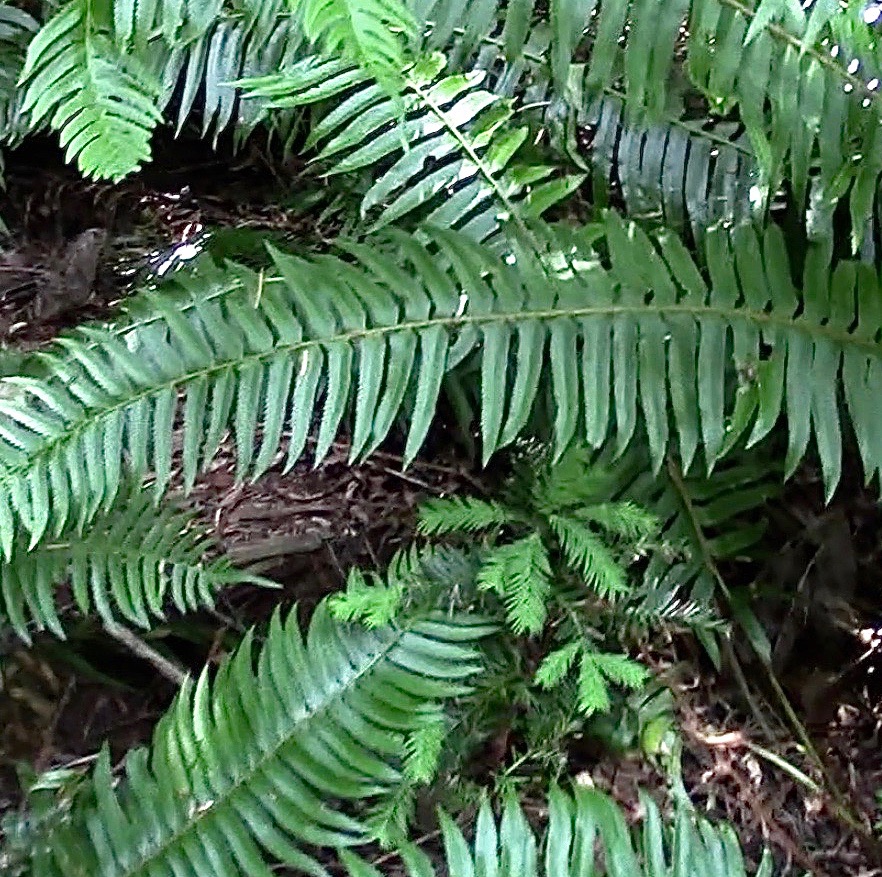 ABOVE LEFT: At Hutt Park north of Seattle, a seedling redwood benefits from moist conditions beneath Swordfern.
ABOVE LEFT: At Hutt Park north of Seattle, a seedling redwood benefits from moist conditions beneath Swordfern.ABOVE RIGHT: At Seabeck WA (along the west side of Puget Sound), a sapling redwood rises among the Swordfern. Coast Redwoods utilize the same form of mycorrhizal fungi (arbuscular) as do all ferns. Western Redcedar is also of the same type. In contrast, Douglas-fir and Western Hemlock form mutualistic relationships with ecto-mycorrhizal fungal types.
Return to top of page
2. Distinguishing Coast Redwood from Its Relatives
ABOVE: The common name, Giant Sequoia, can be confused with the genus name, Sequoia, of Coast Redwood.ABOVE RIGHT: Squirrels and seed collectors harvest Coast Redwood cones when still green, before the scales fully open.
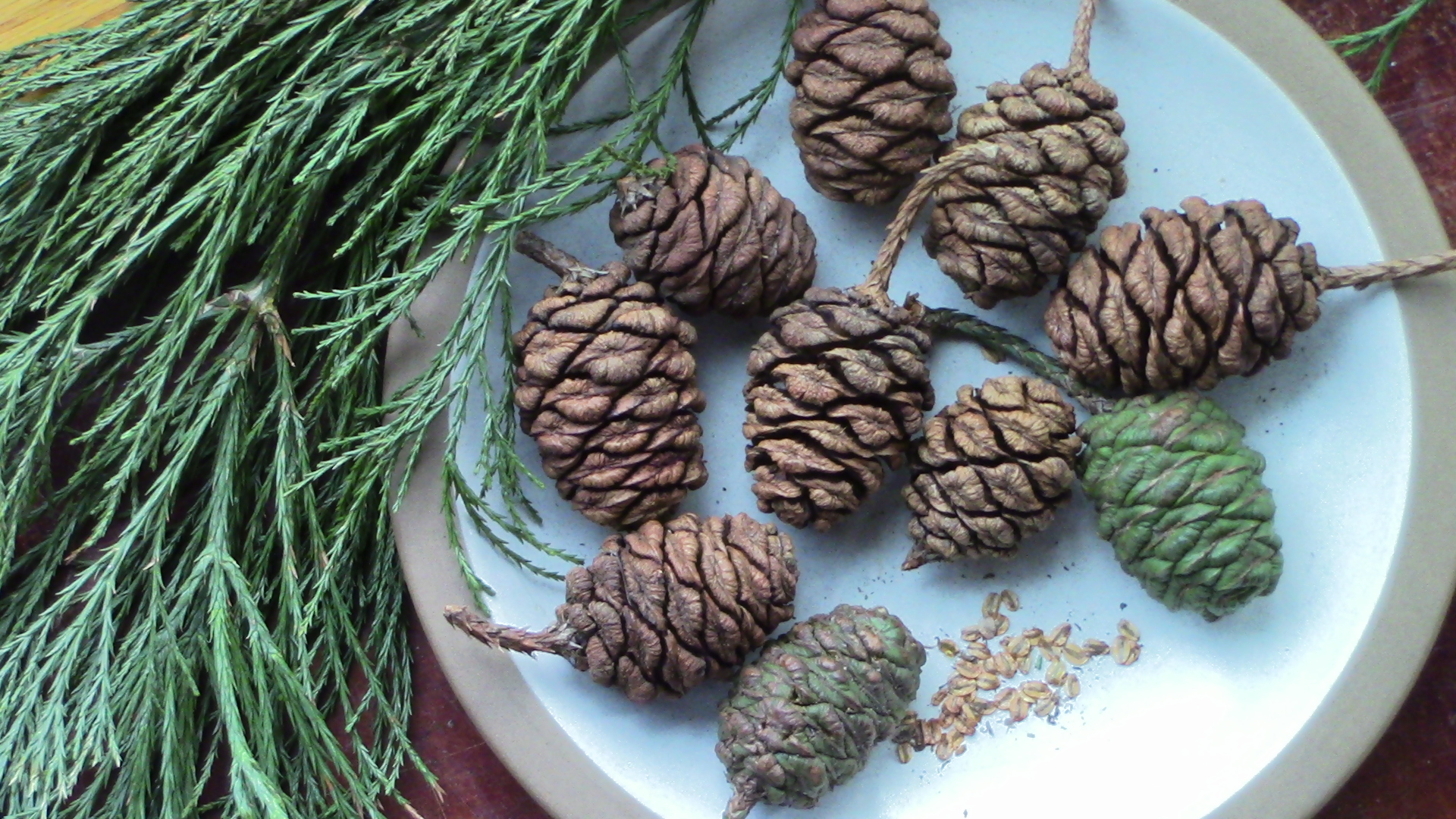
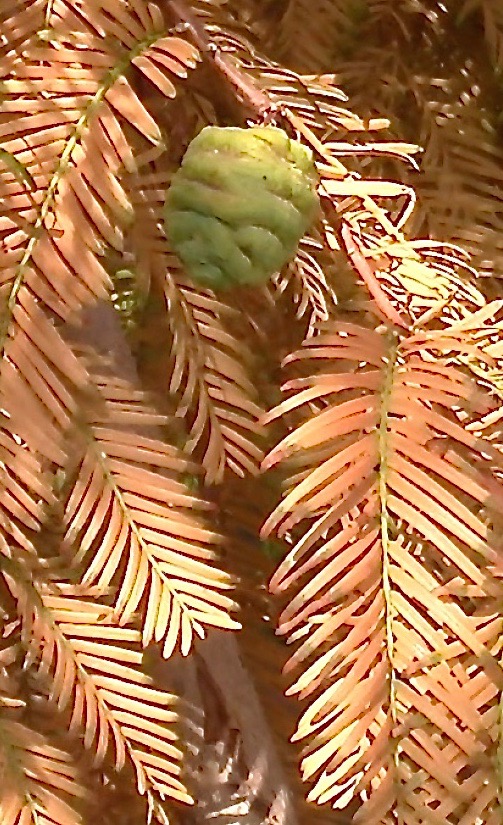 ABOVE: Distinguishing the leaves of Giant Sequoia (left), Dawn Redwood (center) and Coast Redwood (right).
ABOVE: Distinguishing the leaves of Giant Sequoia (left), Dawn Redwood (center) and Coast Redwood (right).Notice how the leaves of Dawn Redwood appear symmetrical, as they are opposite of one another, while the leaves of Coast Redwood are alternate. Dawn redwood is uniquely deciduous, thus its bronze leaves here will soon be falling, leaving the branches bare in winter, as are the branches of its close relative of the eastern USA, Bald Cypress, genus Taxodium.
Return to top of page
3. Maps of Current Range in California v. Global Prehistoric Range
RANGE MAPS: Compare today's very limited range of Coast Redwood and Giant Sequoia with fossil evidence of ranges in warmer times:
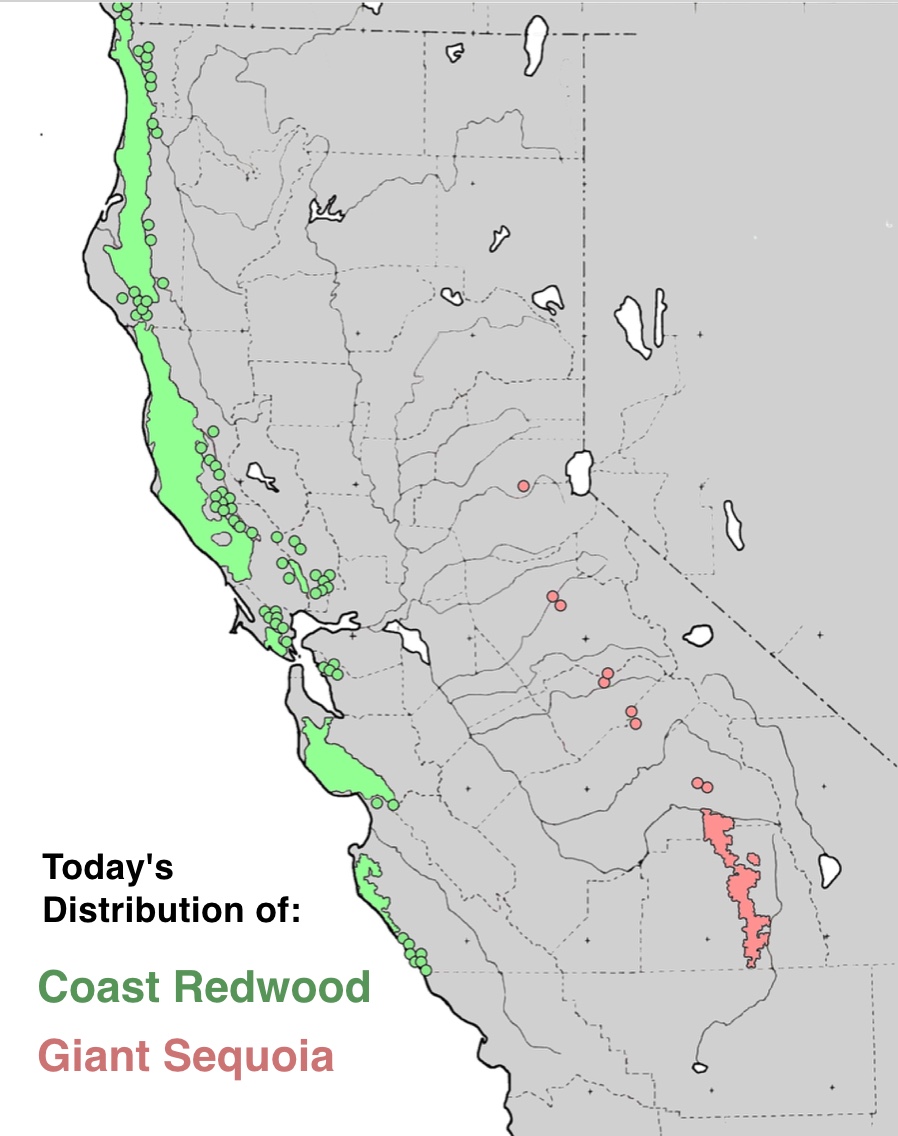
Return to top of page
4. Old Horticultural PLantings in the Pacific Northwest• MATURE HORTICULTURAL PLANTINGS prove that all 3 species of redwoods can live far north of California.
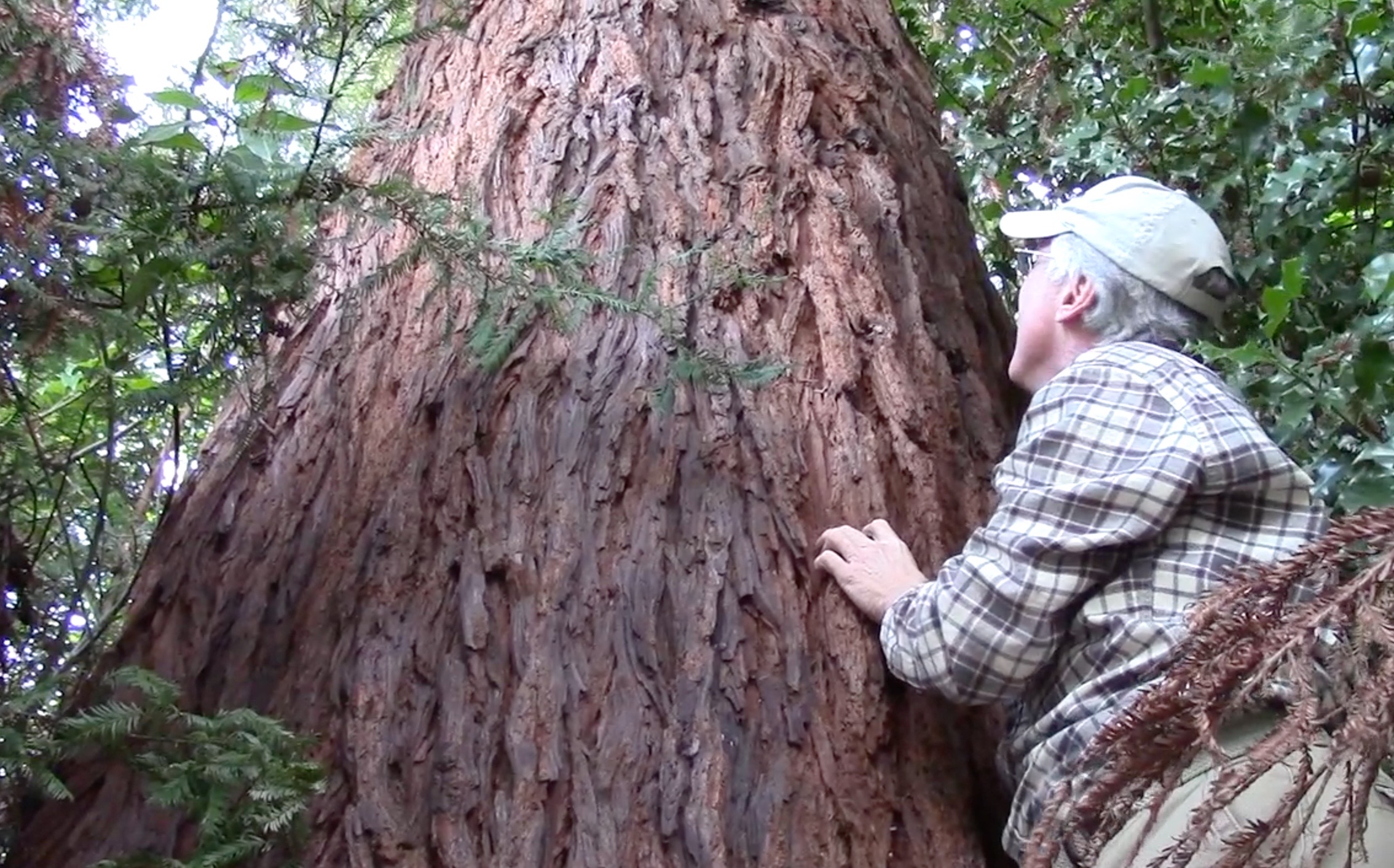 ABOVE: Coast Redwood (left) and Giant Sequoia (right) in old neighborhoods of Portland, Oregon.
ABOVE: Coast Redwood (left) and Giant Sequoia (right) in old neighborhoods of Portland, Oregon.BELOW: Connie Barlow VIDEO-documented examples of horticultural plantings in Seattle and Portland:
Video 60 minutes
Video 44 minutes
Video 33 minutes
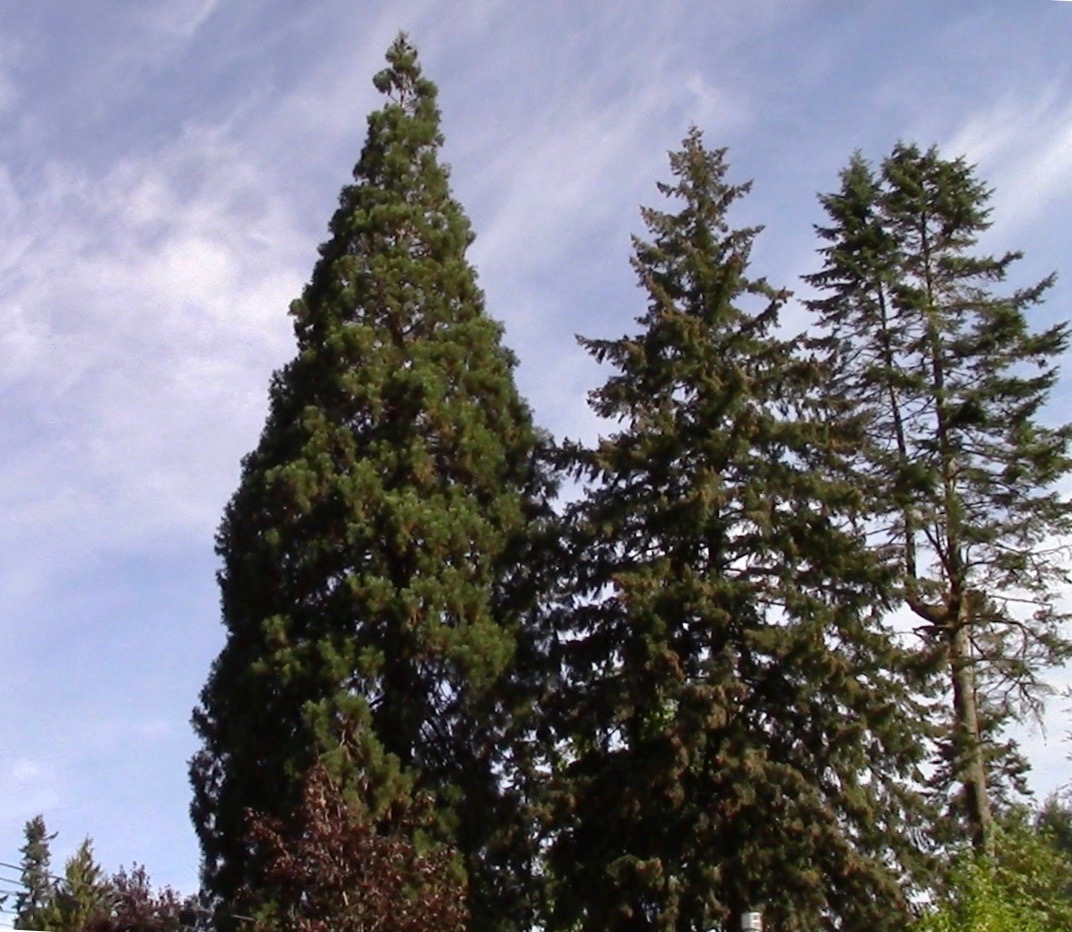
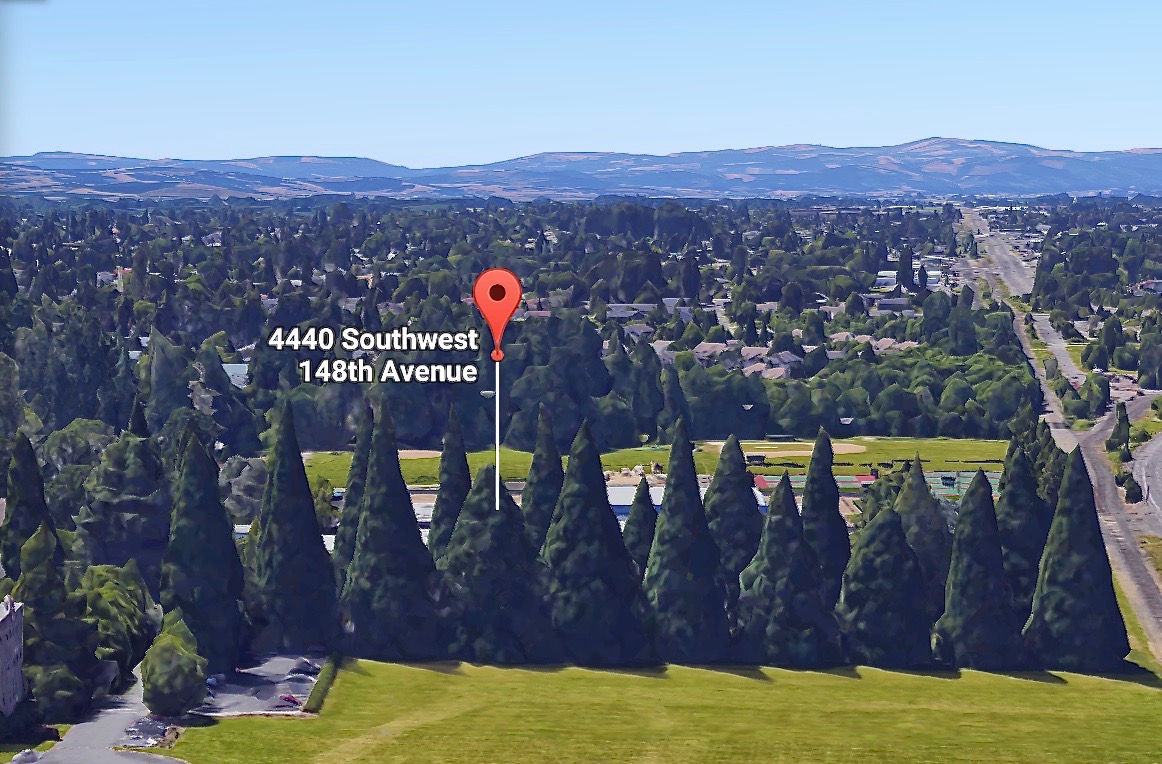
Horticultural plantings of GIANT SEQUOIA in Portland, Oregon, are easy to spot.
ABOVE LEFT shows the thick cone-shaped top typical of Giant Sequoia (versus the Douglas-fir alongside). ABOVE RIGHT is the 3D feature of satellite view on Google maps showing double row of Giant Sequoias at Valley Catholic School in Portland.
LEFT: Also in Portland, citizens managed to save these 3 Giant Sequoias from removal by a developer. A combination of civil protest, children's activism, tree-climbing, and fundraising enabled these legacy trees to continue their lives in 2015.
A 26-minute VIDEO on vimeo records the saga of efforts to save the giants.
Return to top of page
5. Site Visit to a Mixed Redwood and Douglas-Fir Forest along Puget Sound
70-year-old Coast Redwood
at Seabeck WALEFT and ABOVE: The only native plant that can be confused with Coast Redwood is Pacific Yew — but only when redwood is a seedling or sapling growing (as Pacific Yew always does) in subcanopy shade. In both images, Redwood is at left. Connie Barlow finds that the leaf-pull technique is the most trustworthy test: a pulled redwood leaf brings a trail of stem covering at its base.
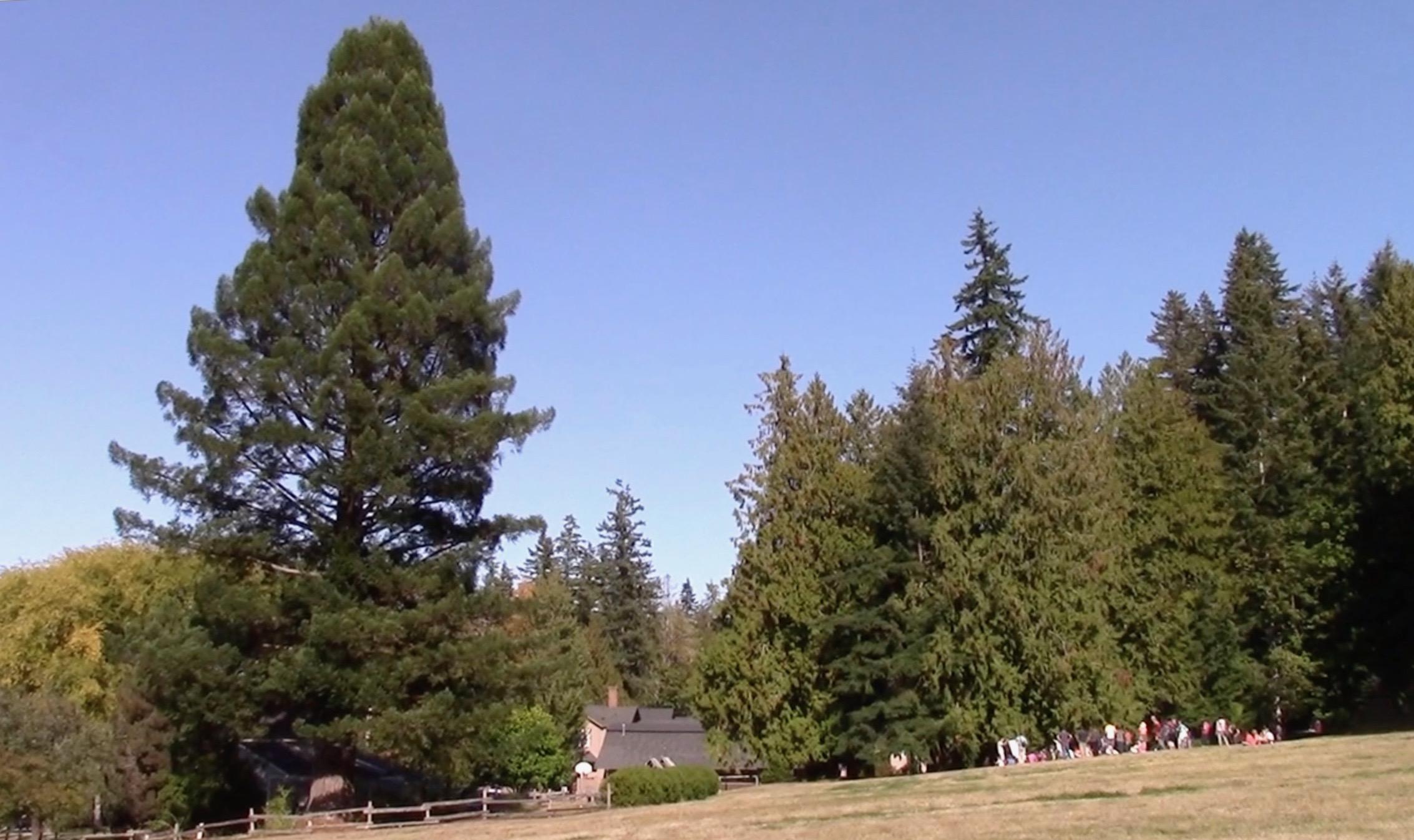
ABOVE: Upslope of the old redwood at Seabeck is a managed, regrowth Douglas-fir forest. During the 1980s, Coast Redwood seedlings were introduced into the forest. In 2019, Connie Barlow stands alongside one of the in-forest planted redwoods. Pacific Yew is onsite, too.BELOW: The within-forest Seabeck plantings have dispersed their offspring, which naturally establish in the full range of subcanopy light conditions. The sapling below left has a growth form typical of partial shade conditions. The sapling below right is along an elevated walkway a few tens of feet from the forest edge.
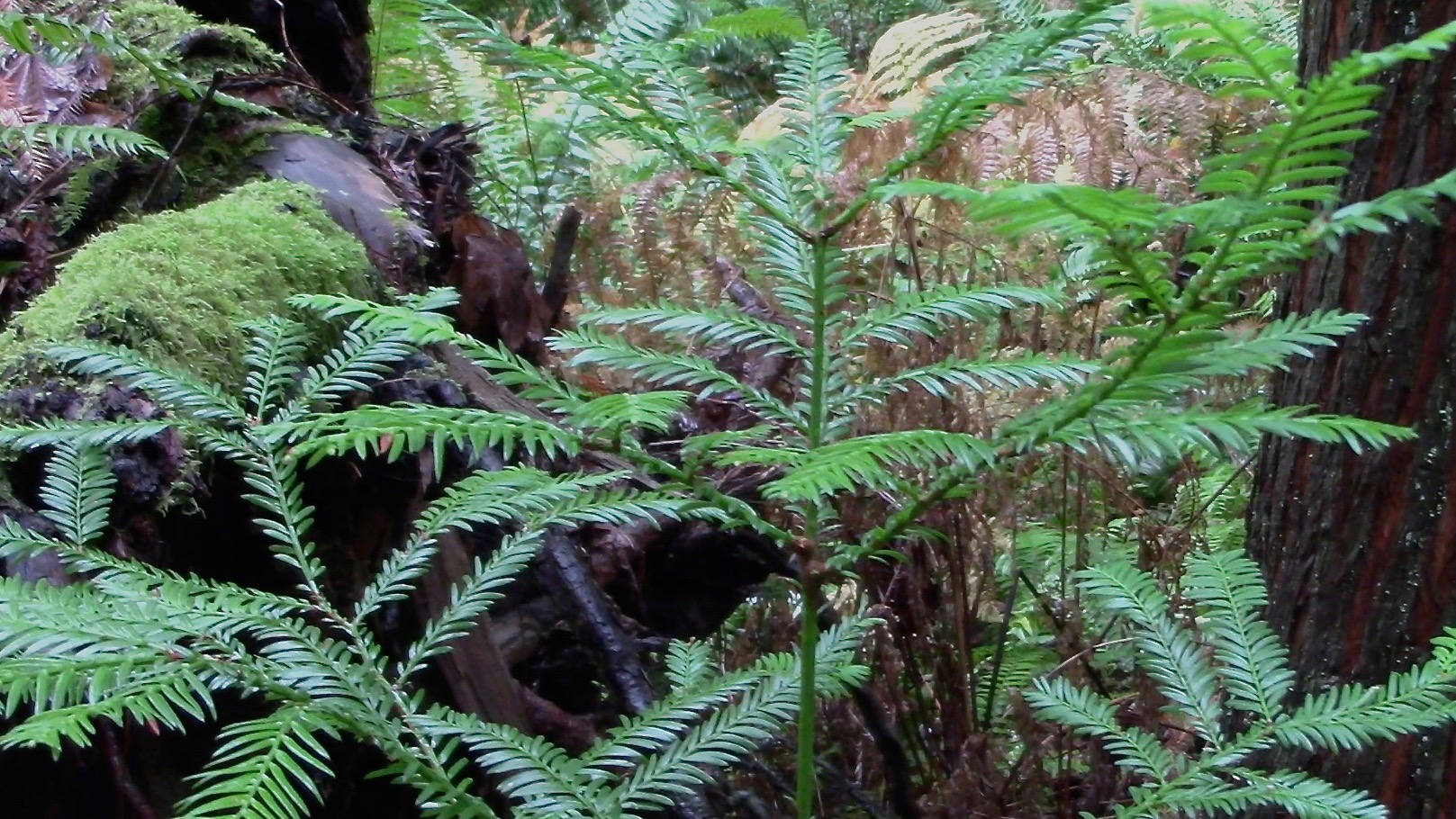
BELOW: The youngest offspring that Connie located within the Seabeck forest is encircled below, with a close-up photo alongside. The crooked dark stem rising to its right is a sapling redwood. Both are growing in dense evergreen shade. Unfortunately, in the 1980s when redwood seedlings were first planted into the forest (and on up to today), local deer are so overpopulated that very few fresh seedlings — whether planted or wild-cast by the elder trees — ever survive the early years of browsing.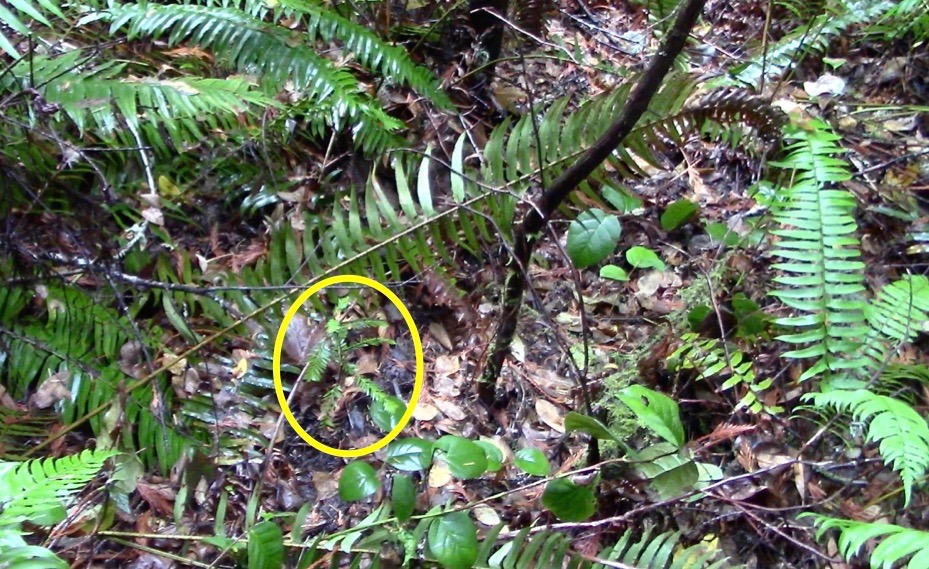
BELOW LEFT: Seabeck Conference Center is the best site in the Pacific Northwest to experience how well Coast Redwood grows and expands within a native Douglas-fir forest — which also contains native Western Redcedar and a few specimens of Western Hemlock. Along the forest edge can be found Bigleaf Maple. Also, inside the forest where the maples had a head-start after logging, they have grown tall where still capable of having a canopy opening.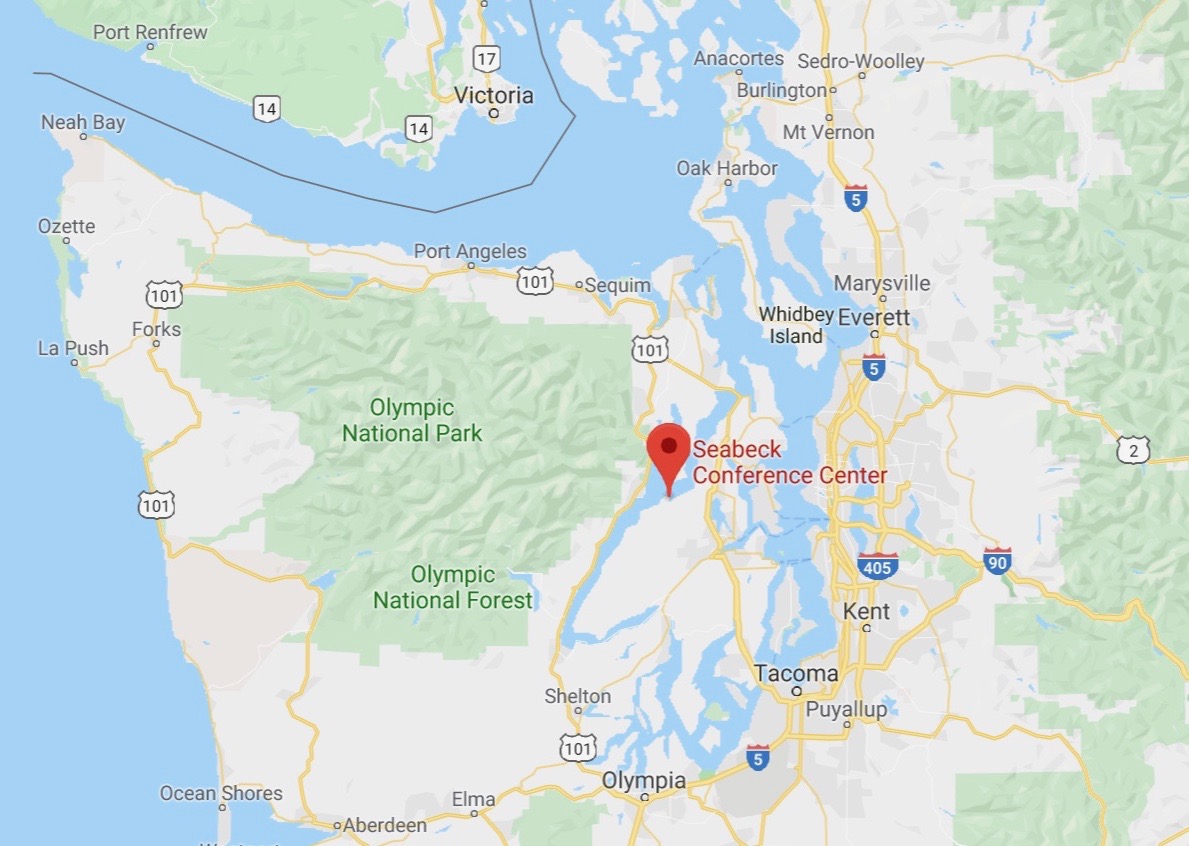
ABOVE RIGHT: An ideal way to learn the growth habits of Coast Redwood in a Pacific Northwest rainforest context is to watch the 61-minute VIDEO.Return to top of page
6. Sun and Shade Capabilities of Coast Redwood
Coast Redwood has a remarkable capability to grow in a big range of light conditions. Redwood leaves evidence visible differences in size, density, waxiness, and UV light protection based on the contexts in which they grow. Being evergreen, each leaf will last for several years. Hence, when planting potted seedlings out onto the landscape, recognize that not only will the roots need to adjust to soil and water conditions but the leaves, too, may show signs of stress or underperformance until new growth presents leaves well suited to the light and humidity contexts.
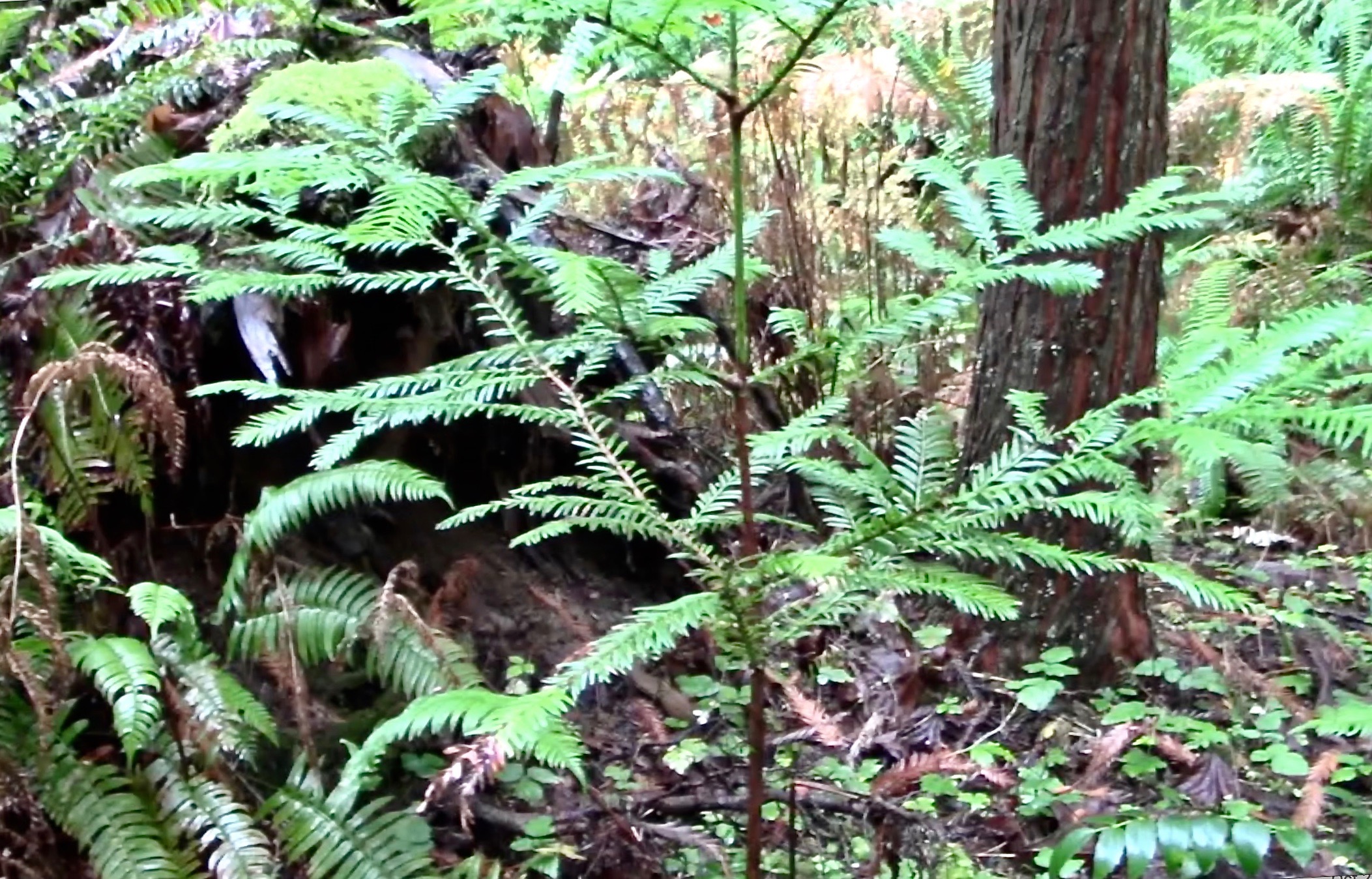 ABOVE LEFT: At Seabeck WA, seed that established naturally has produced a seedling that grows in the partial shade of a much older redwood, visible behind. Notice the long vertical growth spurts, with the upper two stem segments still green — despite the shade.
ABOVE LEFT: At Seabeck WA, seed that established naturally has produced a seedling that grows in the partial shade of a much older redwood, visible behind. Notice the long vertical growth spurts, with the upper two stem segments still green — despite the shade.ABOVE RIGHT: Also at Seabeck WA, the seedling in the foreground has the advantage of deciduous shade of Bigleaf Maple on one side. Being evergreen, and in a landscape not subject to hard winter freezes, redwoods can photosynthesize during the winter — and thereby benefit from winter openings in the deciduous canopy.
Return to top of page
7. Redwood Landscapes in California: Photo TourLearn about habitats and collaborative species via photos
7A. Regrowth Redwood Forest (near Eureka, CA)
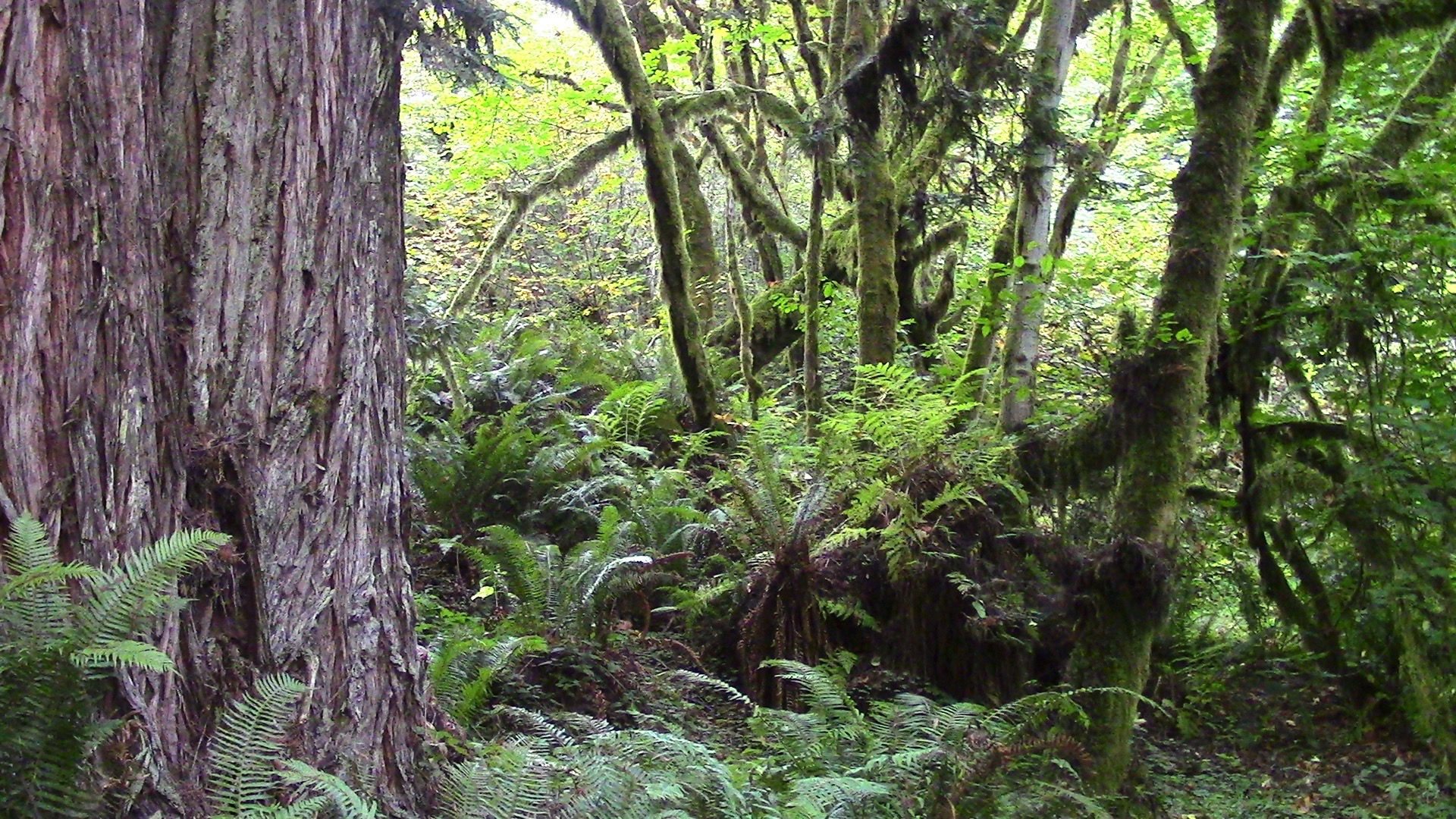 ABOVE: Forests near Eureka, California were logged long ago and have now regrown. This small tributary of Freshwater Creek has dense swordferns and moss-covered stems of Bigleaf Maple just a few feet above the creek bottom — where Coast Redwood cannot grow. In the left photo, the big trunk in the foreground is Coast Redwood occupying the first bench above the creek.
ABOVE: Forests near Eureka, California were logged long ago and have now regrown. This small tributary of Freshwater Creek has dense swordferns and moss-covered stems of Bigleaf Maple just a few feet above the creek bottom — where Coast Redwood cannot grow. In the left photo, the big trunk in the foreground is Coast Redwood occupying the first bench above the creek.
The same tributary as shown in the previous two photos is off to the right here. This is the first bench above the creek; this is where the redwoods begin. They are all regrowth. An enormous old redwood stump is visible to the left, with regrowth stems emerging from its edges.
The path follows the course of what was either an oxen-cart "road" for hauling out logs, or a narrow-gauge railway.
The spring green along the path are herbs but also vast patches of Redwood Sorrel.
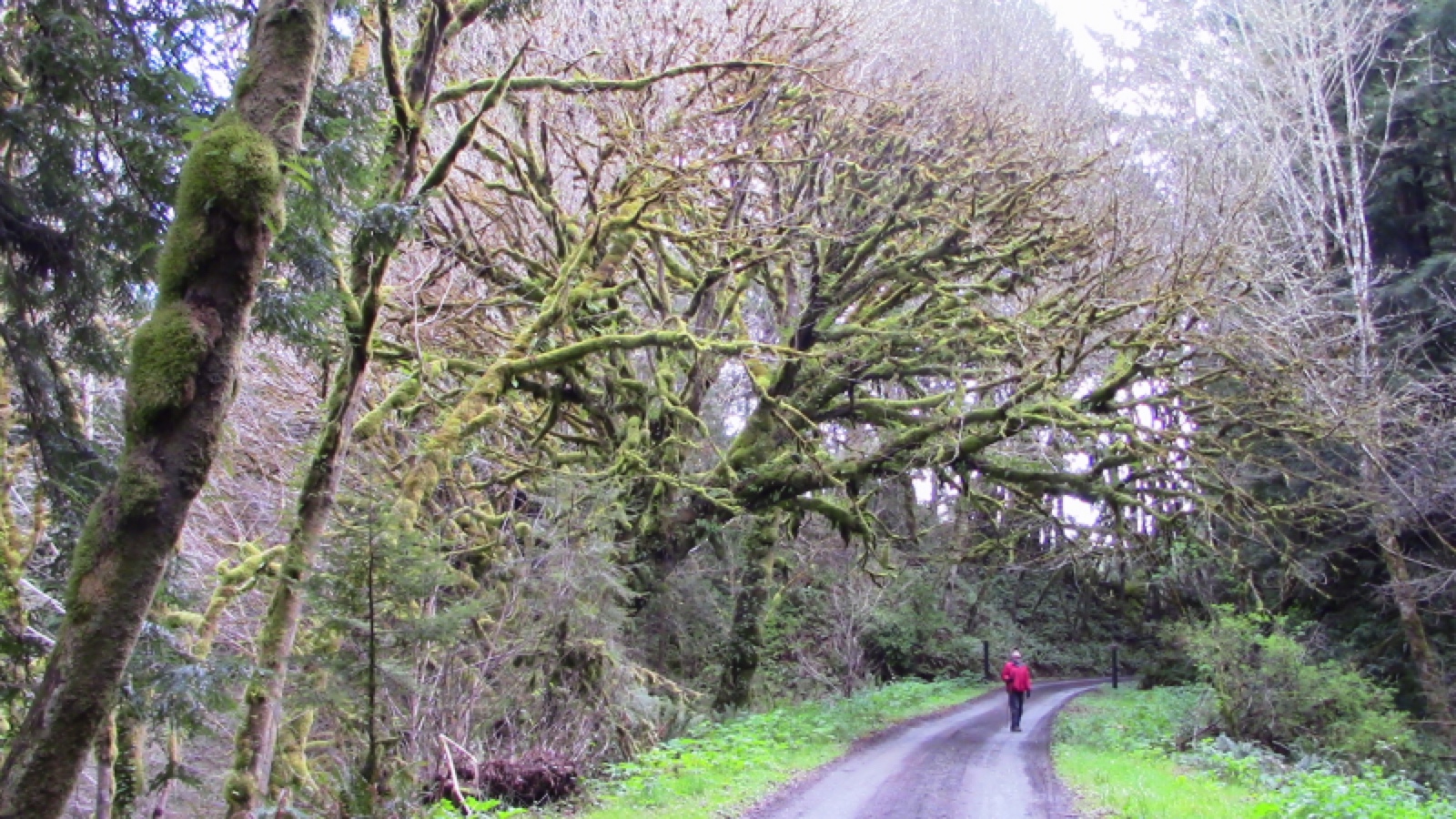 ABOVE LEFT: The floodplain of Freshwater Creek is where these Bigleaf Maples (free of leaves during the winter) are rooted. Sediment was dug and heaved up from the right in order to establish this private road, still maintained for heavy logging trucks harvesting regrowth redwoods and some Douglas-fir upslope and upstream.
ABOVE LEFT: The floodplain of Freshwater Creek is where these Bigleaf Maples (free of leaves during the winter) are rooted. Sediment was dug and heaved up from the right in order to establish this private road, still maintained for heavy logging trucks harvesting regrowth redwoods and some Douglas-fir upslope and upstream.ABOVE RIGHT: This is the area to the right of the road that had been excavated for road fill. Now the lowland area is entirely filled with swordfern and shaded by regrowth redwoods. A big old redwood stump is visible in the background. As the slope rises, Douglas-fir become more abundant. Both species are logged in this region, though not within the environmental protection zone established for Freshwater Creek.
Two ancient stumps, light brown in color are visible in this photo. The stump at the right bears marks where once-deep holes were cut to hold the boards on which the sawyers stood. All the remaining stems are basal sprouts that rose up following the logging. Possibly the two stumps are close enough to have themselves been twin basals, arising after the original tree was topped by wind or killed by fire. The original tree would have lived long prior to the arrival of Euro-Americans.
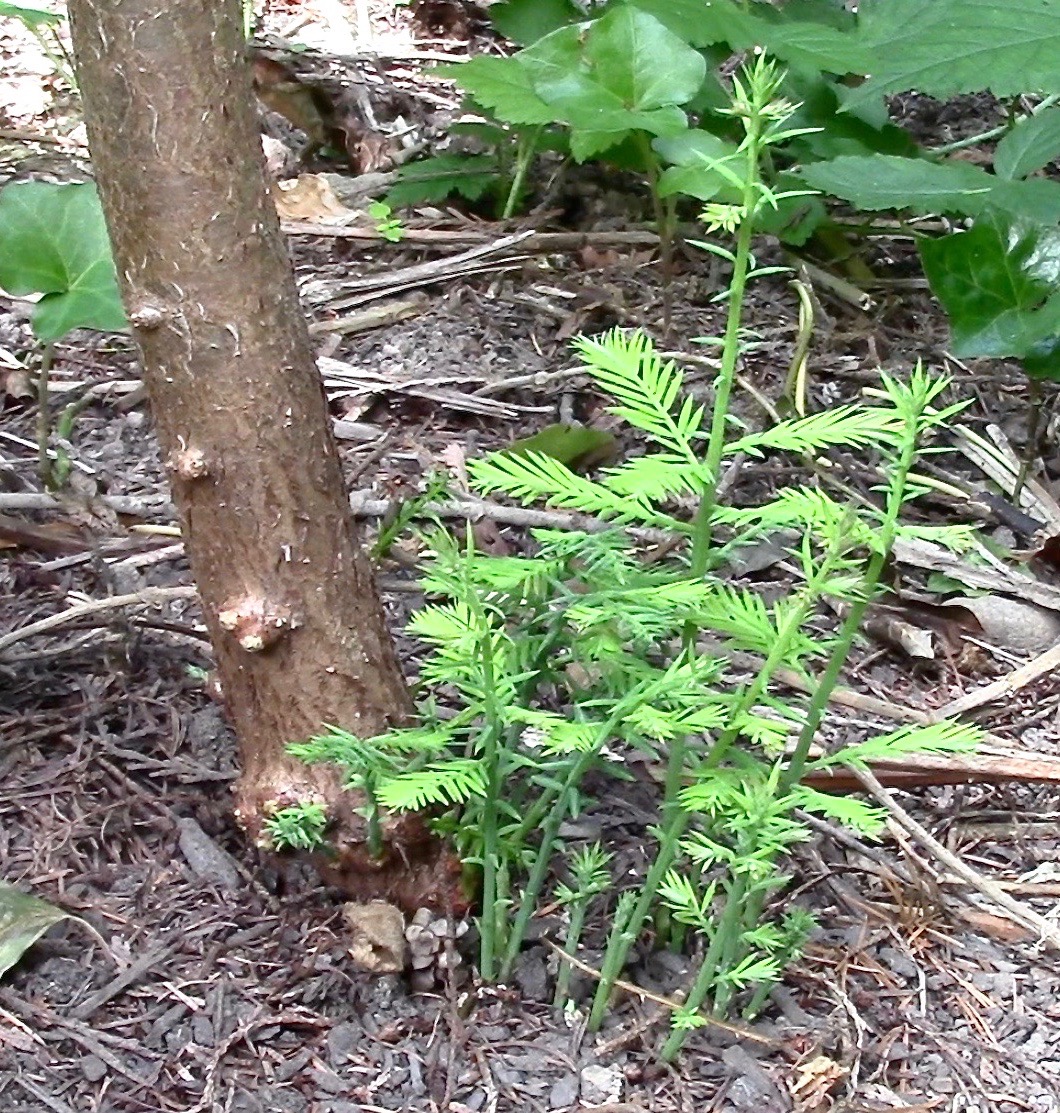 ABOVE RIGHT: An eroding bank along a Freshwater Creek tributary made it possible for Connie to photograph the business end of the "lignotuber", which is usually underground. All these round protuberances are capable of becoming basal stems (or roots) — if and when the need arises. And notice, too, the same protruberances showing on the lower part of the redwood stem in the left photo.
ABOVE RIGHT: An eroding bank along a Freshwater Creek tributary made it possible for Connie to photograph the business end of the "lignotuber", which is usually underground. All these round protuberances are capable of becoming basal stems (or roots) — if and when the need arises. And notice, too, the same protruberances showing on the lower part of the redwood stem in the left photo.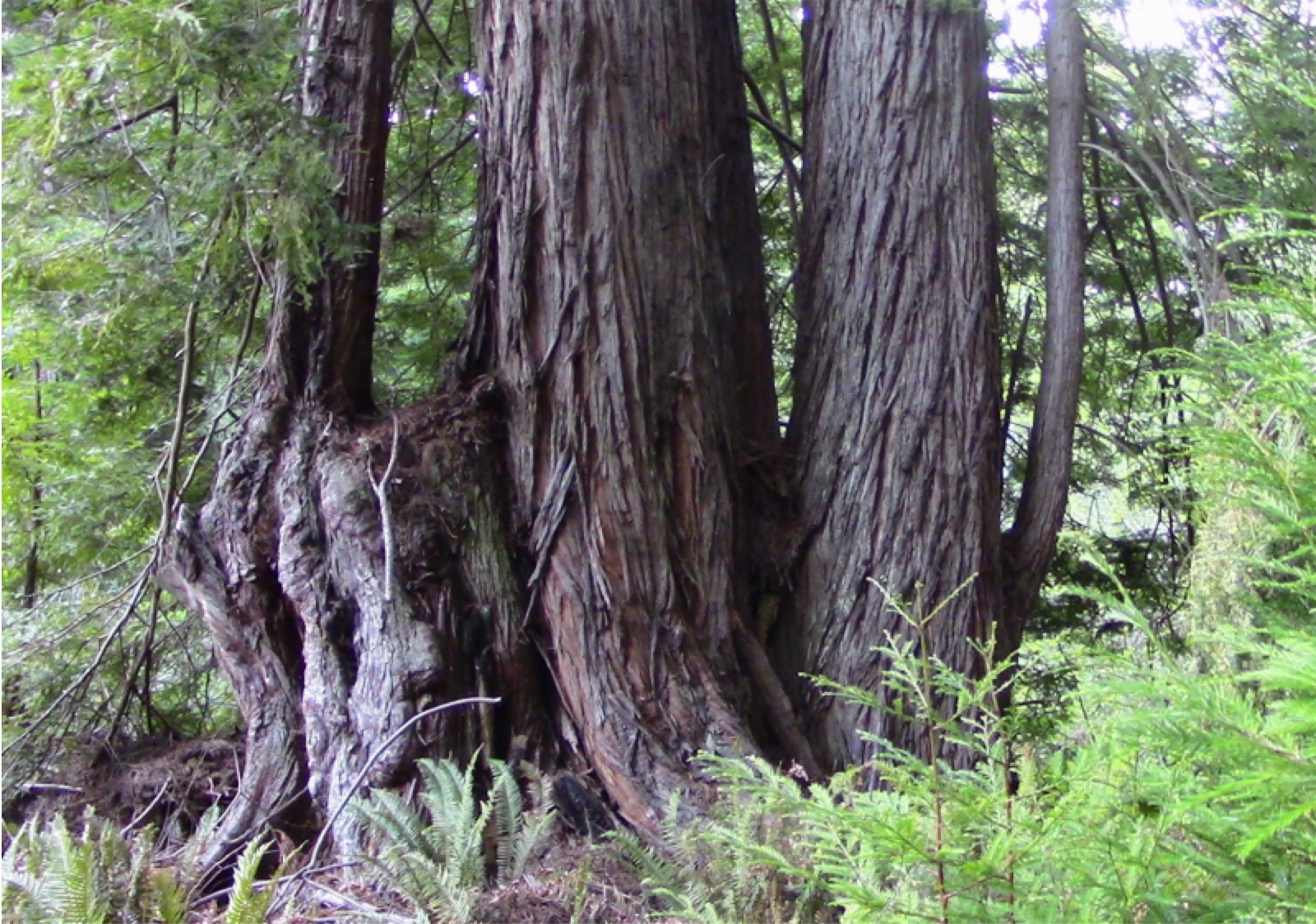 ABOVE: Two examples of basal growth and lignotuber exposure that developed after the logging road was established or widened. The photo at right shows a lignotuber seeming to ooze down the new sloping grade.
ABOVE: Two examples of basal growth and lignotuber exposure that developed after the logging road was established or widened. The photo at right shows a lignotuber seeming to ooze down the new sloping grade.BELOW LEFT: Along the same logging road, off the side that drains into Freshwater Creek, appears this tall set of basal stems in full sun. The original logged trunk is low and behind the three basals in front. At their right (beyond the photo) can be found evidence of an old staging area with a road that curved down to the creek itself. The flat ground in front of this set would have been pushed in to expand the width of the road. This set is close enough to the creek to be in the watershed protection zone, and therefore will never again be logged.
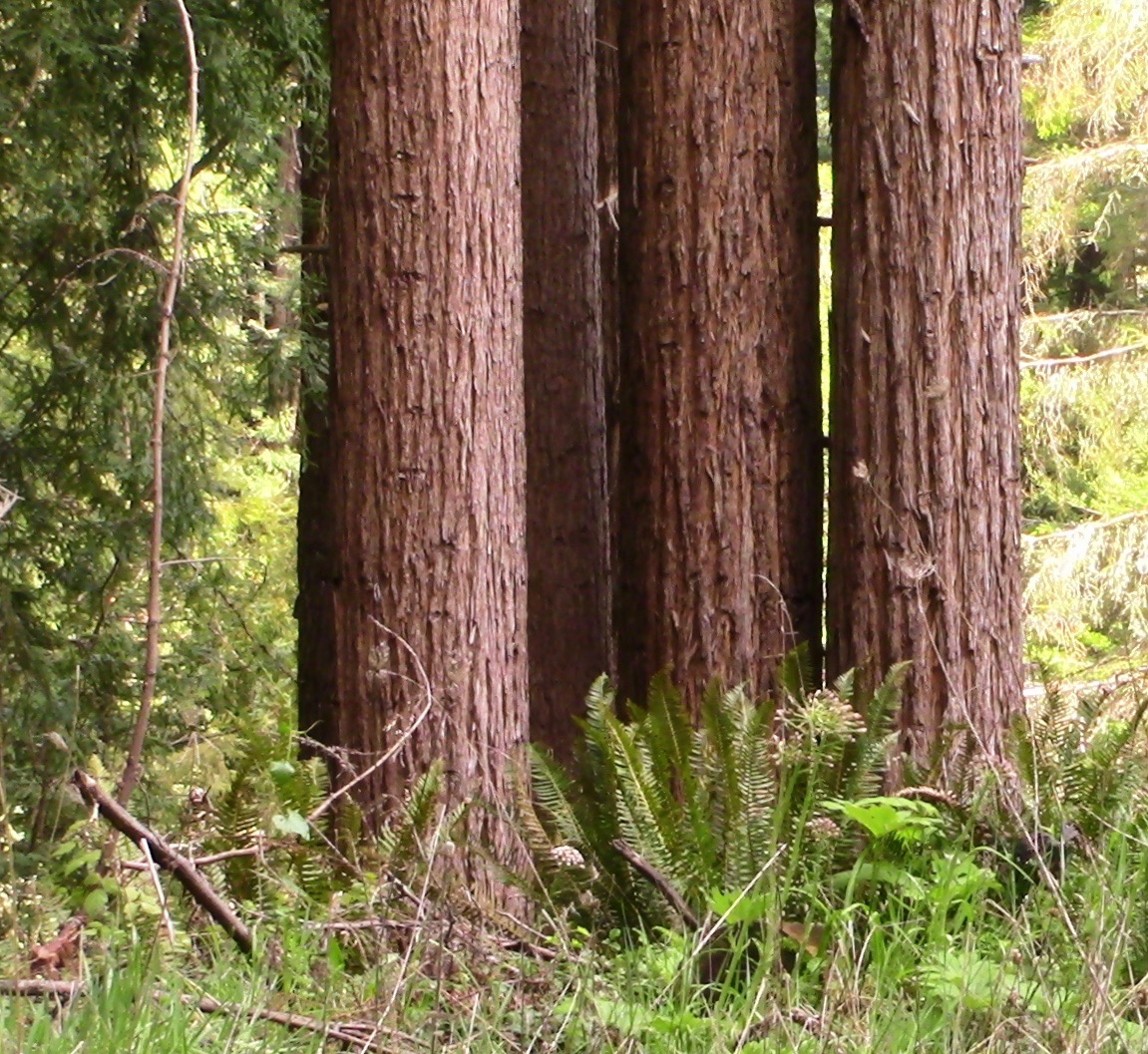 ABOVE RIGHT: The bulging lignotubers of this giant in the protected Rockefeller Grove of the Redwood National Park system stands ready to issue forth new basal stems. Thankfully, this old one seems to have no need to do so.
ABOVE RIGHT: The bulging lignotubers of this giant in the protected Rockefeller Grove of the Redwood National Park system stands ready to issue forth new basal stems. Thankfully, this old one seems to have no need to do so.
Photo by Archangel Ancient Tree ArchiveLEFT: Barrett Stump. Fortunately, some of the biggest Coast Redwoods are still alive — even a century after they were logged. Time and again, basal stems arise, as can be seen in the photo.
When Archangel Ancient Tree Archive learned that the Barrett stump was still producing basal stems, the group jumped at the chance to collect cuttings.
Obtaining permission from the owner (whose walkway can be seen extending into the stump), the team arrived to marvel at the tree and collect cuttings in 2010.
CONCLUSION: THE AMAZING REDWOOD! All the regrowth redwoods seen in the Eureka section above are astonishing as trees and astonishing for how well this species preserved the soil and ecosystem — despite the abhorrent logging practices of the early redwood industry. The combination of lignotubers plus strong basal growth enables this species — uniquely among all its western USA coinhabitants — to keep its ancient rootstock alive (via basal photosynthesis), after logging, while it begins to re-establish vertical stem growth. The Rockefeller Grove stem directly above is certainly old, but it most likely arises from an even older rootstock. As well, the whole set of redwoods on the flat elevated terrace of the Rockefeller Grove likely have fused their roots with one another. Fused roots help with nutrient, water, and photosynthate sharing. Fused roots also prevent the giants from toppling over in strong winds.Unlike the Pacific Northwest, coastal California has mountains and valleys never smoothed and widened by glaciers. Imagine how eroded the steep slopes would have become had those early timber extractors been primarily harvesting tree species other than redwoods!
Return to top of page
7B. Other Tree Species in Old Growth Redwood Forests
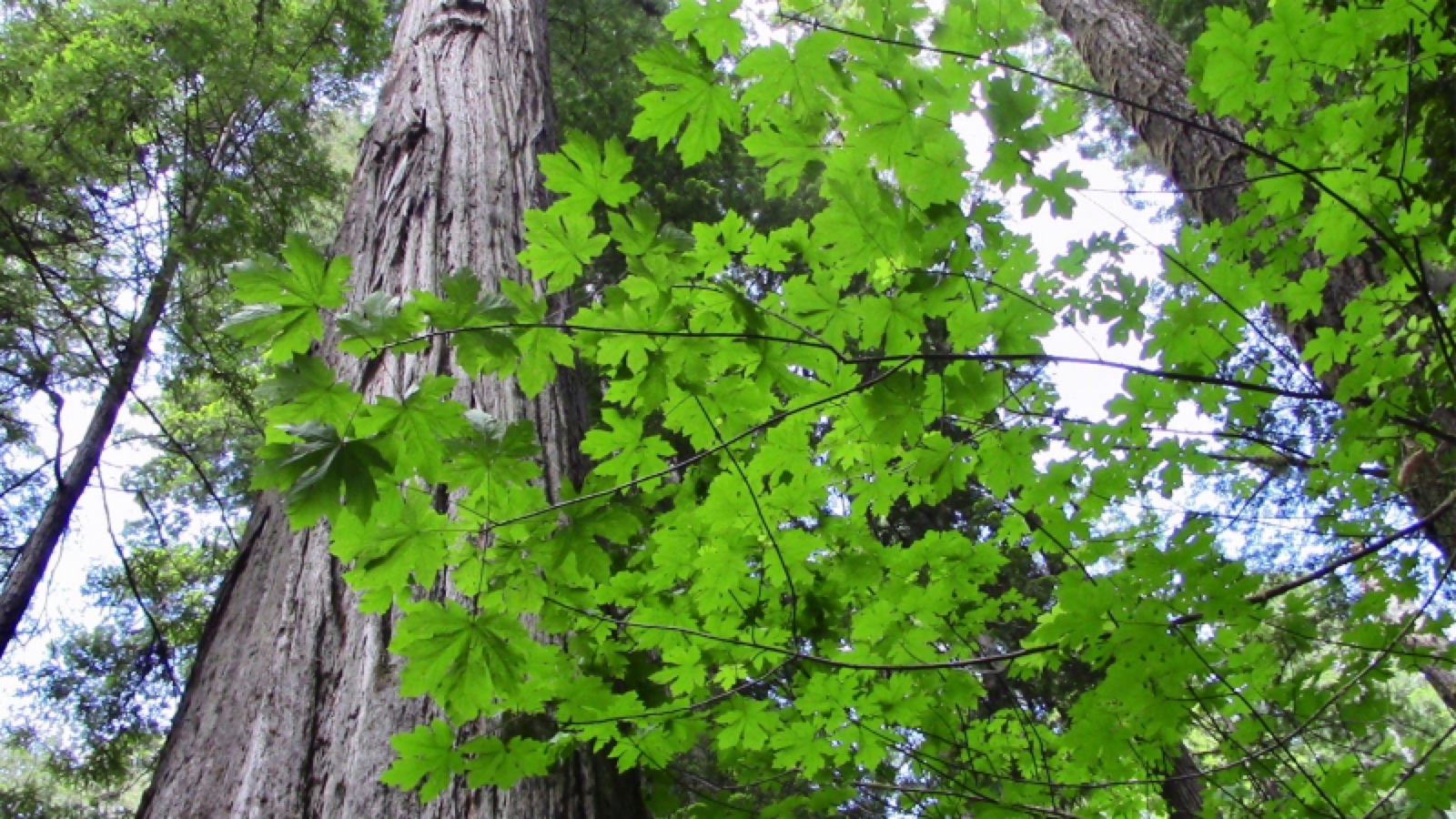 ABOVE: BIGLEAF MAPLE in Prairie Creek State Park
ABOVE: BIGLEAF MAPLE in Prairie Creek State Park
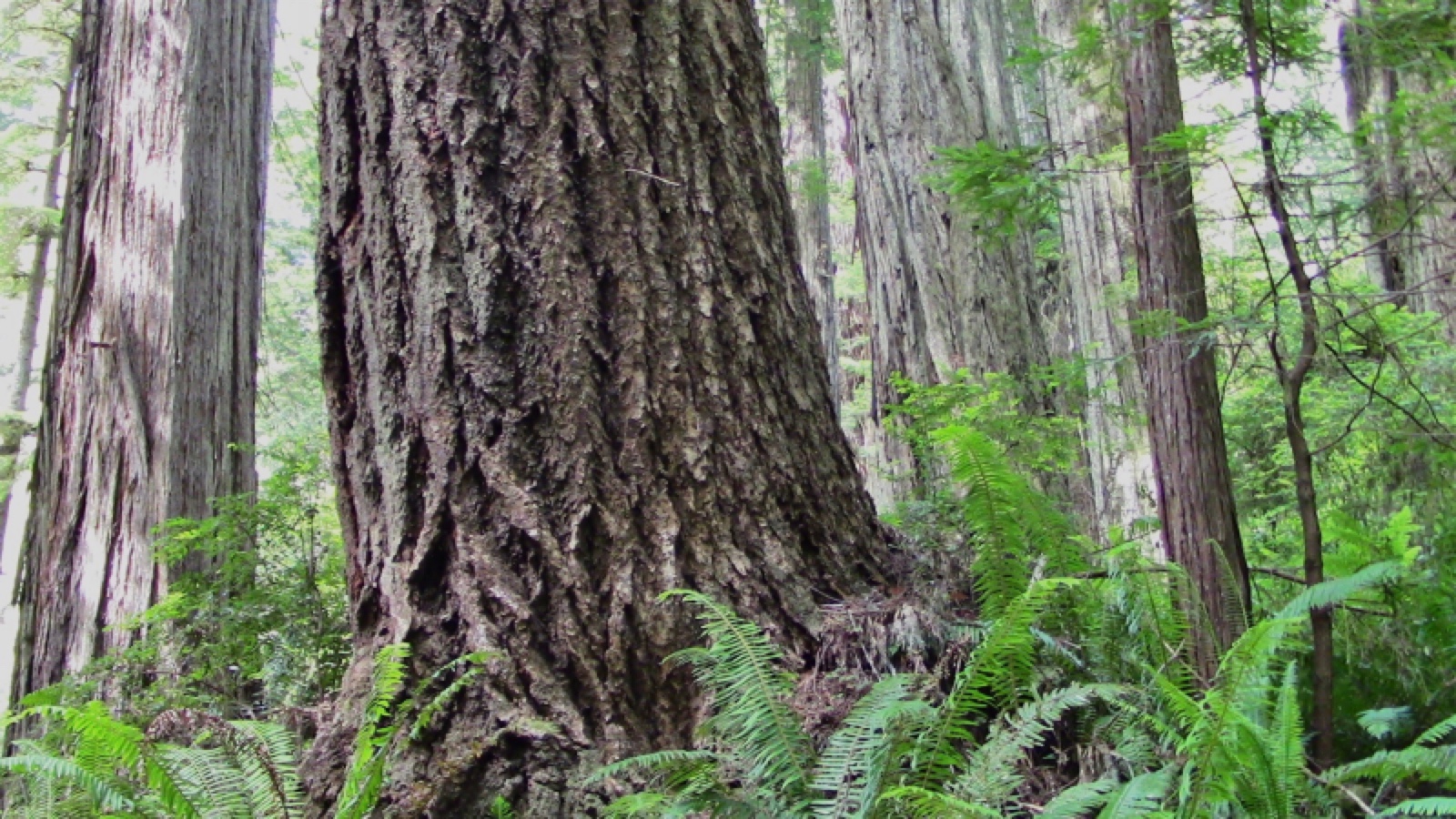
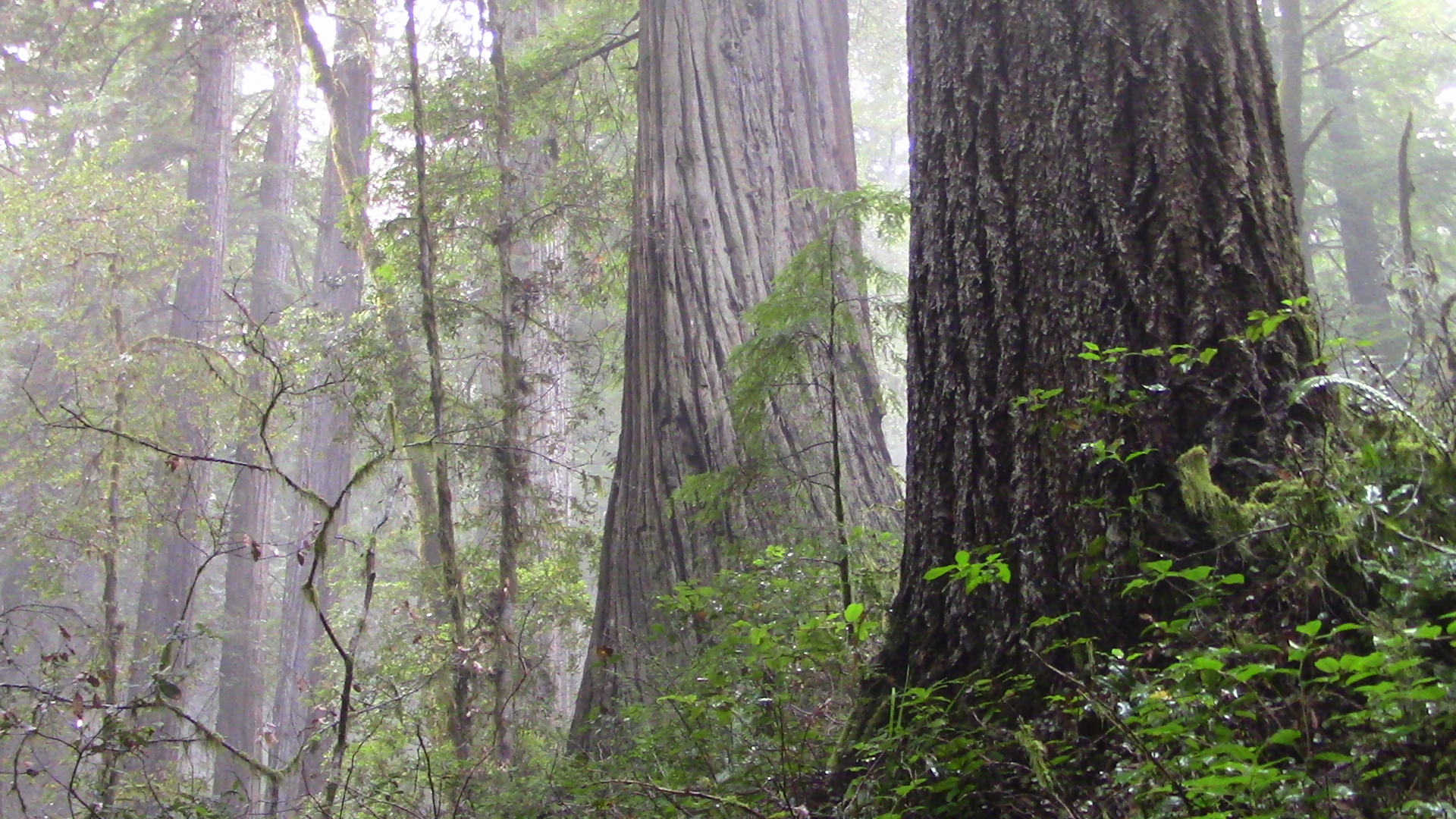 ABOVE: DOUGLAS-FIR in Prairie Creek State Park (left) and a foggy Lady Bird Johnson Grove (right)
ABOVE: DOUGLAS-FIR in Prairie Creek State Park (left) and a foggy Lady Bird Johnson Grove (right)
LEFT: Rarely does one see a WESTERN HEMLOCK (center) standing its own ground in an old-growth redwood forest. BELOW: However, Western Hemlock has no rival when it comes to quickly occupying the top surface of a fallen giant, where a spot in the sun is guaranteed — at least for awhile.
Photos left and directly below: Lady Bird Johnson Grove.
Corner left: Prairie Creek State Park.
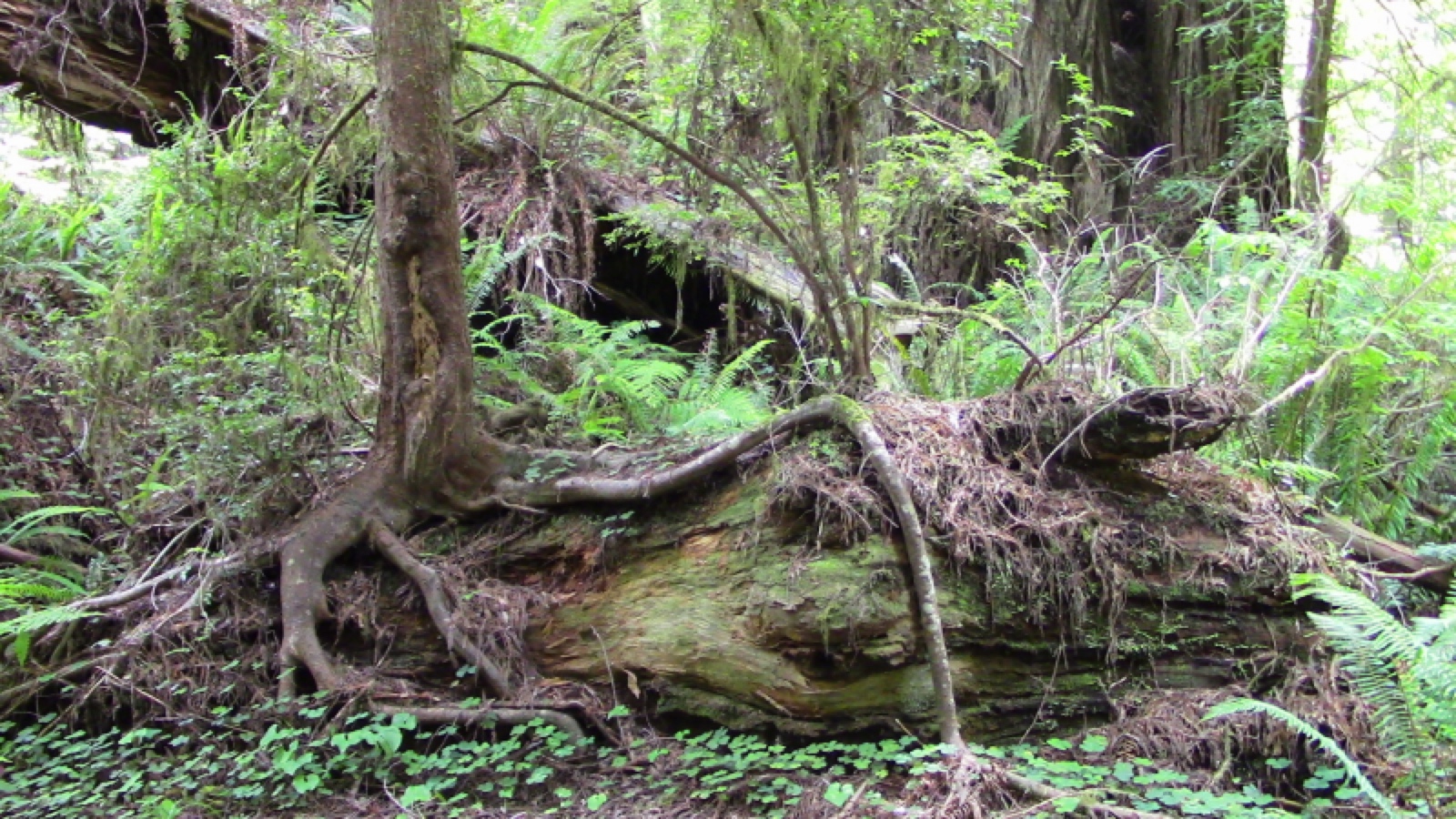
LEFT: A magnificent SITKA SPRUCE shows its buttressed best along the trail upslope from Fern Canyon. Coast redwoods are behind. BELOW: Walking farther inland along the same trail, the spruce loses dominance. The redwoods prevail.
Notice how the spruce uniquely maintains nubs of its lower branches, now covered with moss.
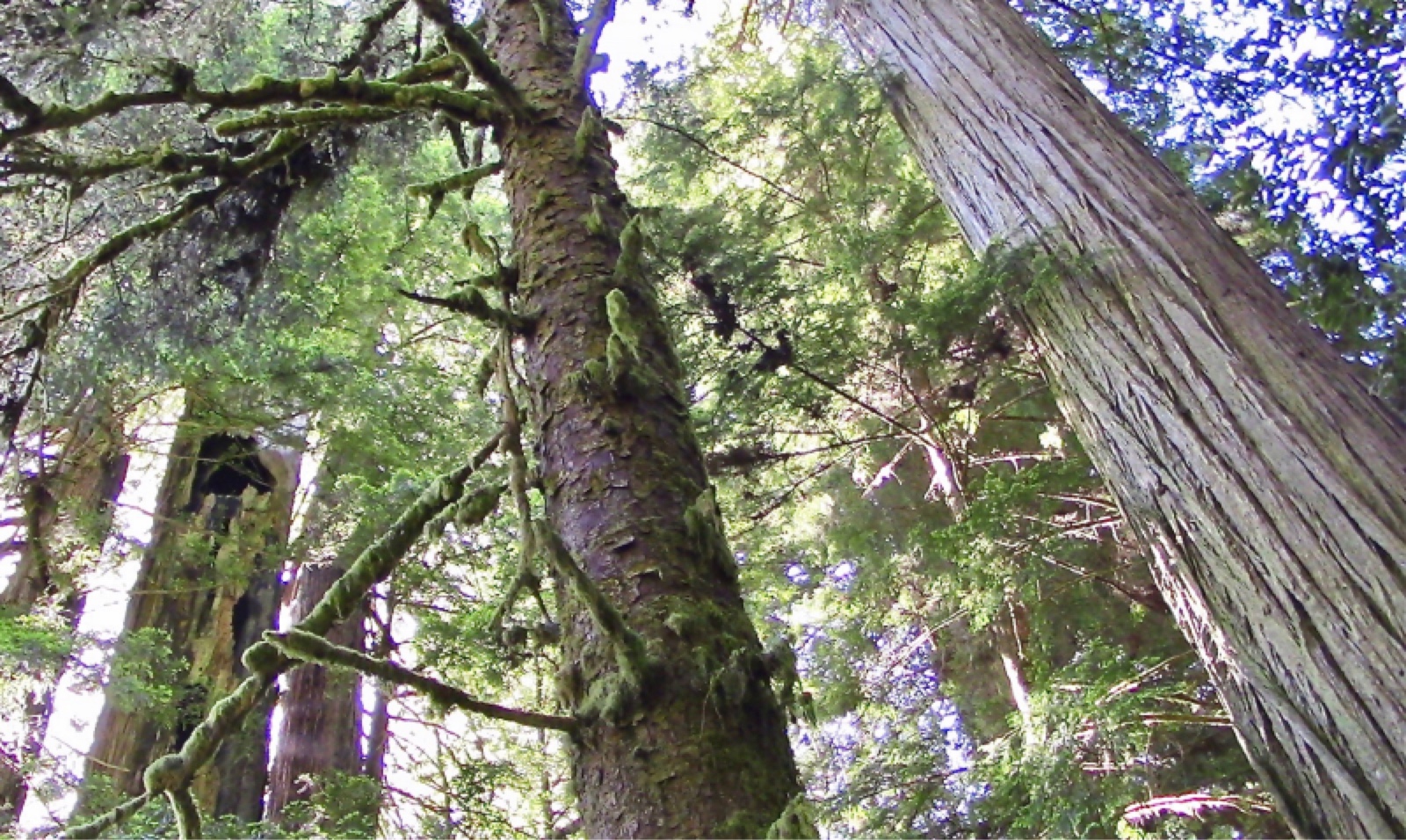
BELOW: Fern Creek Trail overland route begins nearly at tidewater; this zone is vulnerable to salt spray — which Coast Redwood cannot tolerate. Hence, this early, low-elevation part of the trail is entirely Sitka Spruce. Spruce cannot grow basals — but it can grow "knees" to help its roots breathe.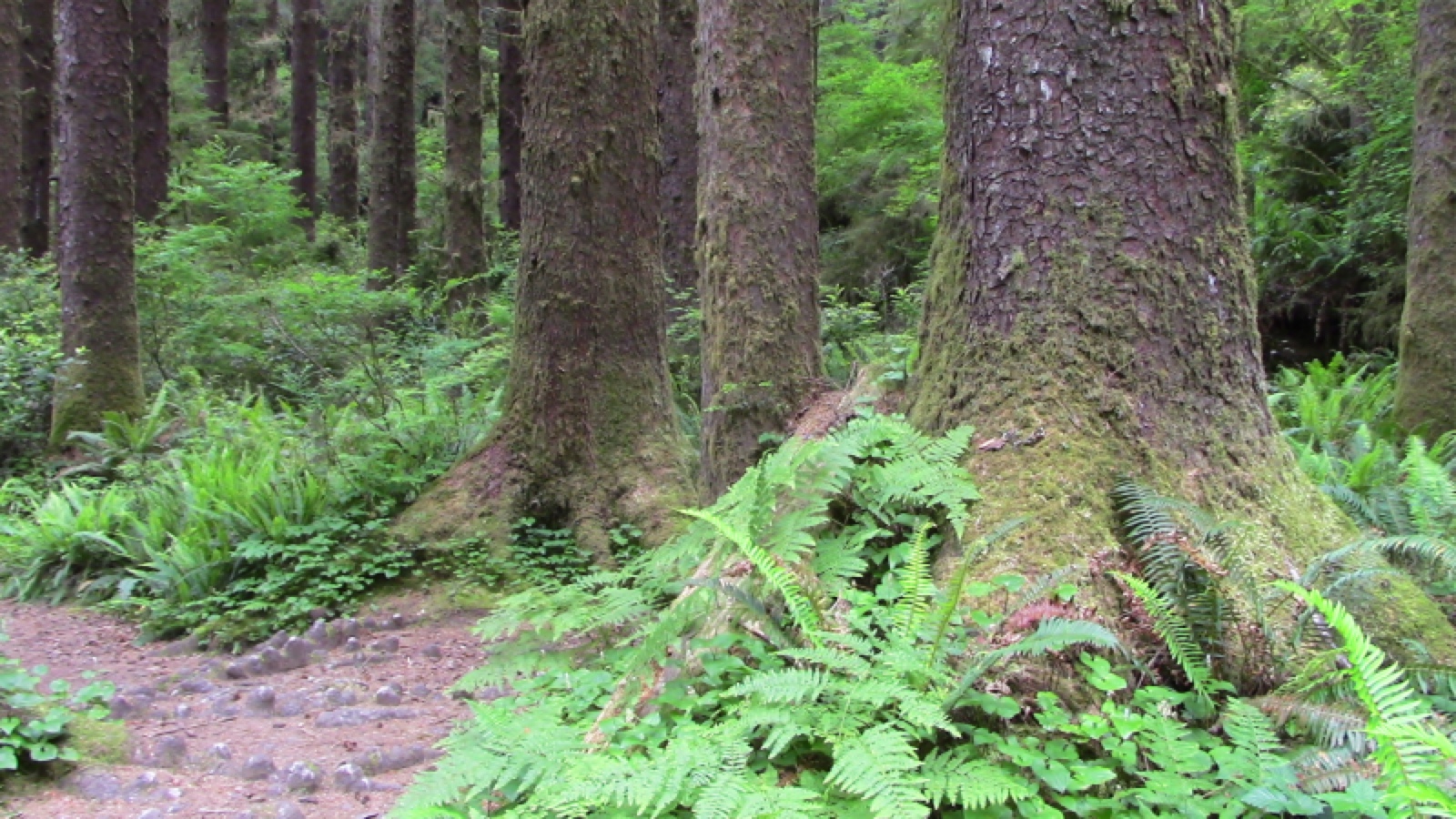 BELOW: Evidence of Sitka Spruce's capacity to tolerate salt spray can be found along the coast where the rise of land is made gradual by the outflow of a great river (Little River). Here, north of the coastal town of Arcata, a young Sitka Spruce stands alone amid the dominant grasses and shrubs. The nearby dwarf forest is entirely spruce, too.
BELOW: Evidence of Sitka Spruce's capacity to tolerate salt spray can be found along the coast where the rise of land is made gradual by the outflow of a great river (Little River). Here, north of the coastal town of Arcata, a young Sitka Spruce stands alone amid the dominant grasses and shrubs. The nearby dwarf forest is entirely spruce, too.
Connie Barlow shows the lush branching structure of the spruce in this full-sun (and full-fog) habitat. There will never be old-growth spruce here. Tsunamis regularly push the reset button.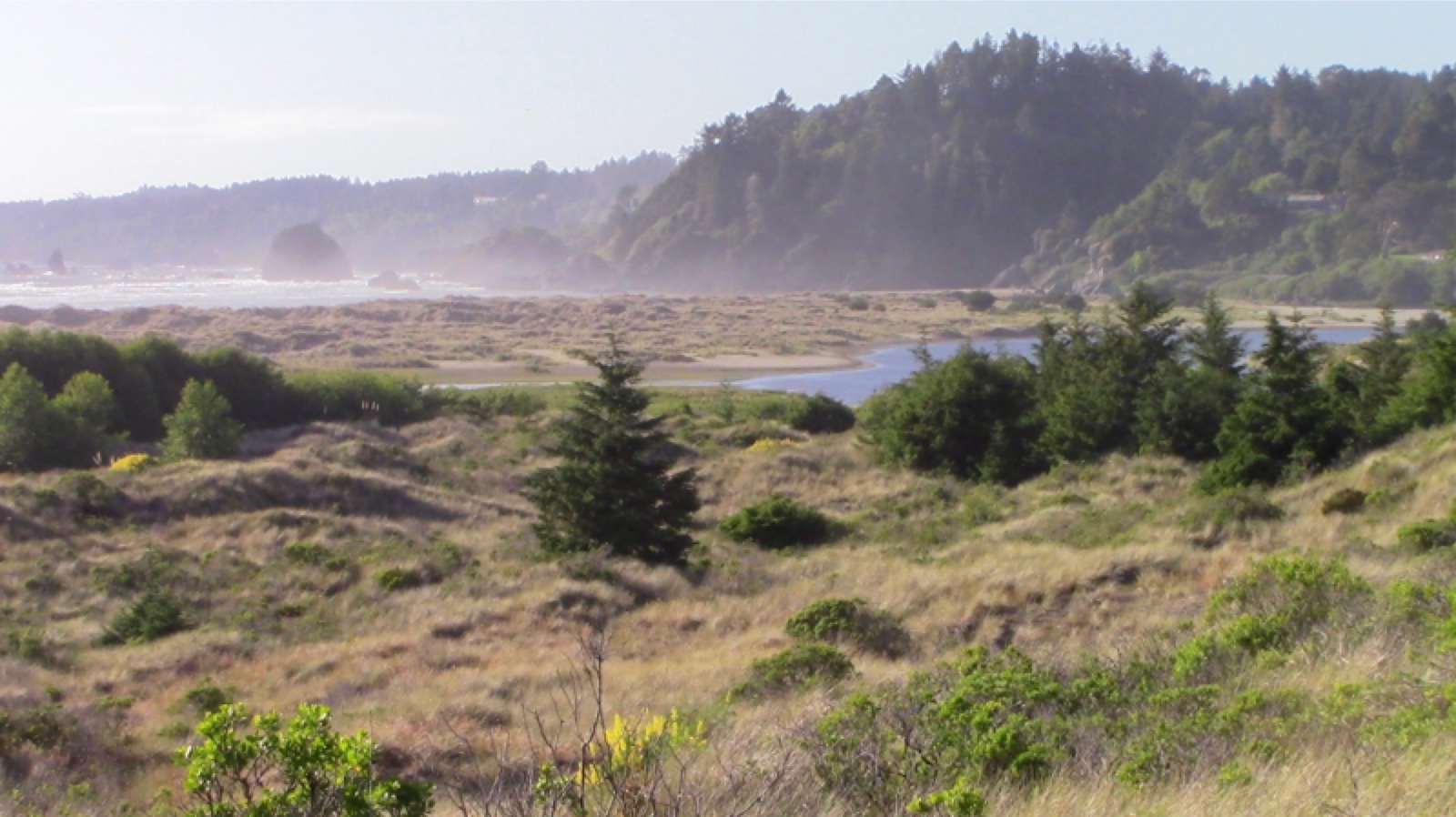
7C. Video Tour of the Northern-most Redwood Grove (Oregon)
CONNIE BARLOW WRITES: In all my explorations of Coast Redwoods within the Redwood National Park system and previously logged regions, I have never experienced a location more redolent of a sense of current and future exuberant life for Coast Redwood than this northern-most protected grove. It was here (and only here) that I found cones galore dropped along the trail. It was here that I spotted redwood seedlings and saplings in all stages of development — and too numerous to count. ABOVE: A redwood sapling, bark darkened by rain, rises within a bed of swordferns at Chetco Creek OR.
And so it was here that I established, firmly, that the most magnificent redwood to my eyes is not to be found in the old growth reserves, no matter how wondrous they still may be. Rather, it was the little one just beginning to peak up through the shelter of its nurse-plant Swordfern.
I witnessed that ongoing miracle and drive to thrive as far north as this species could travel on its own: in the Chetco River natural area. I'd like to think that other humans will soon also find a fierce hope for the future — not by walking amid the old ones, but by welcoming their offspring into the region of the Salish Sea.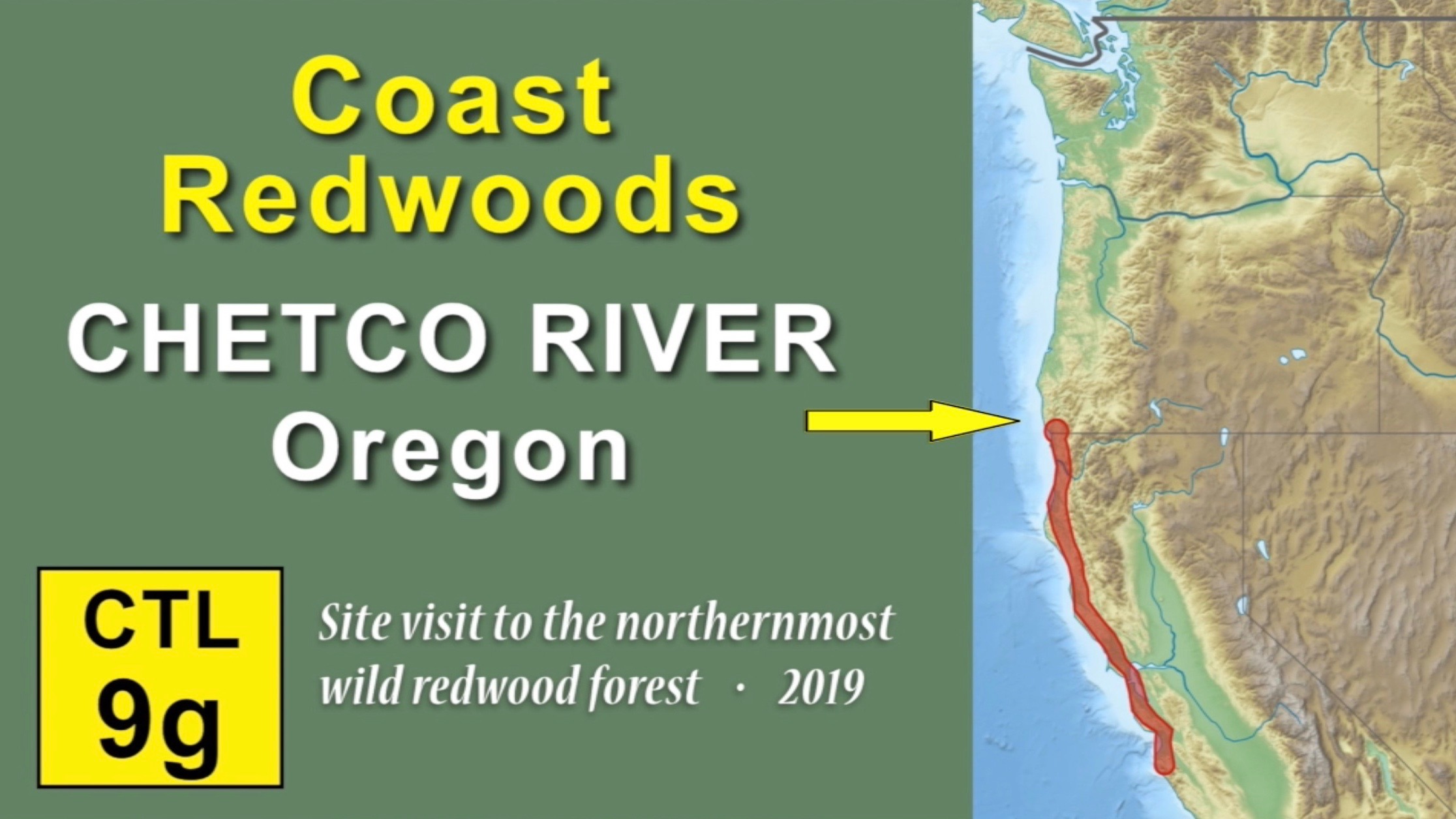
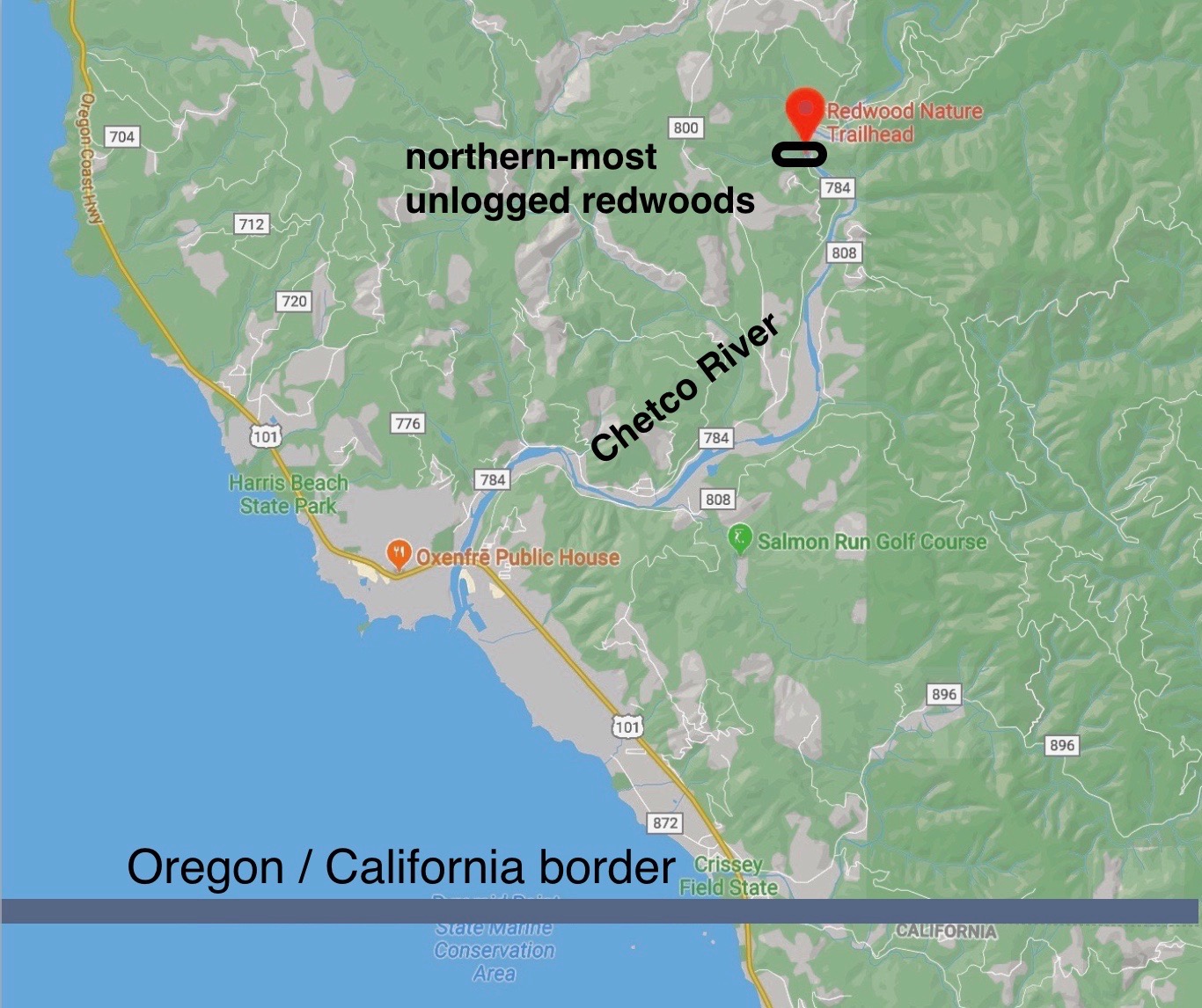
Access 25-minute VIDEO
Growth Capacities of Coast Redwood
Access a set of technical essays by Connie Barlow, created from 2019 through 2023.The set is photo-rich and includes helpful excerpts from scientific papers on the 6 topics as listed in the image below.
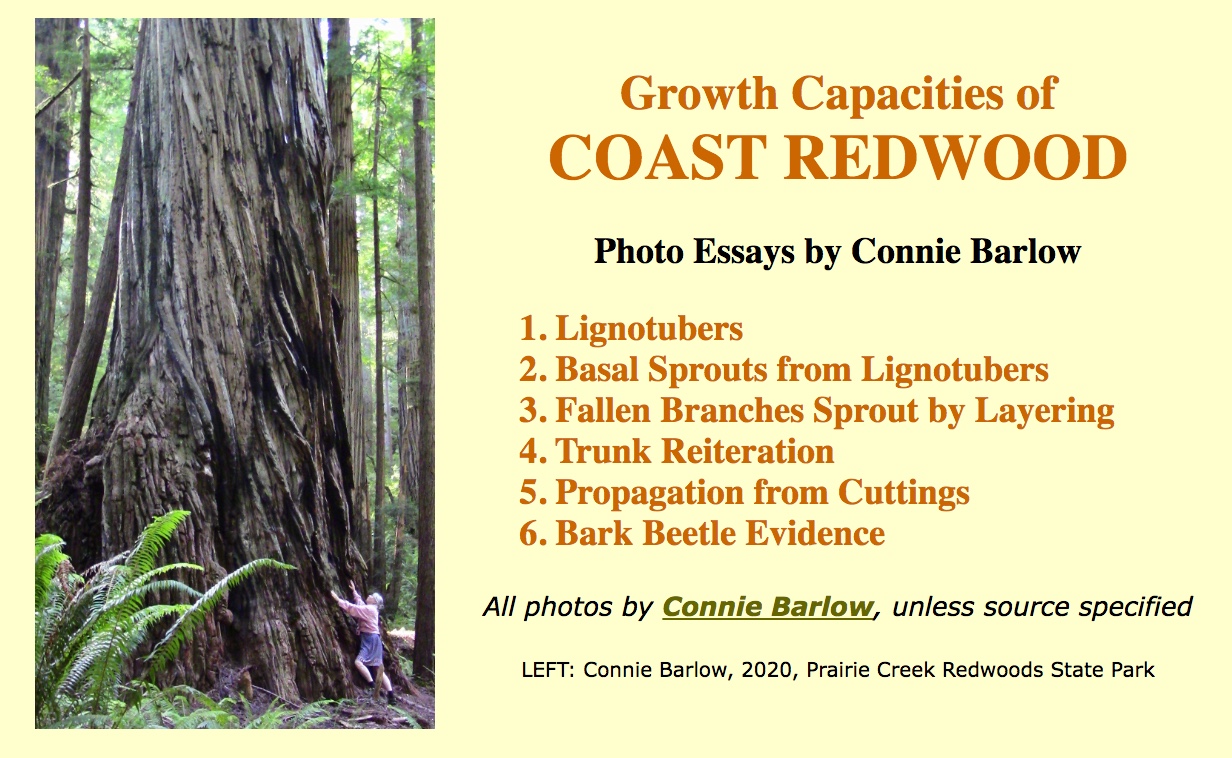
Appendix: 1000 REDWOODS Project - Press Release & Photos (October 2021)

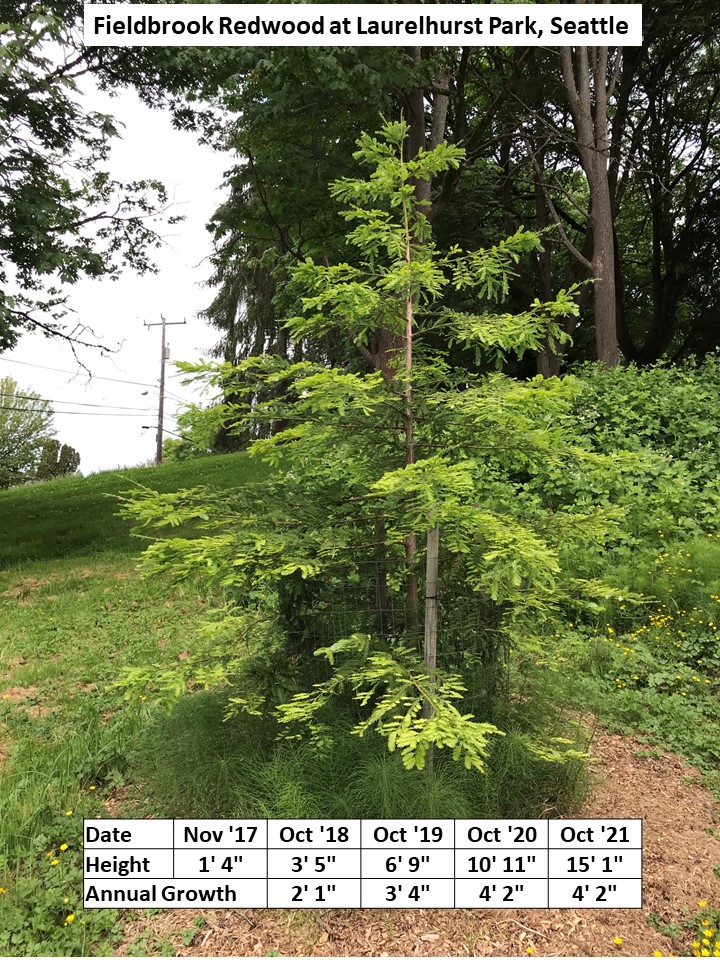 ABOVE LEFT: Project press release, October 2021.
ABOVE LEFT: Project press release, October 2021.UPPER RIGHT: Historic photo of Fieldbrook Stump, near Arcata, from Ericson Collection, Humboldt State University.
LOWER RIGHT: The Fieldbrook Coast Redwood gets a new start in Seattle. Thanks to successive landowners who, through neglect or benevolence, allowed the stump to keep raising new basal stems as needed, the tree's roots remained alive. In 2010, the Archangel team took cuttings from the basal stems. By 2017, potted trees of the same champion genetics were ready to plant, along with other cloned giants, in the Seattle area. Philip Stielstra added a table of annual growth to this 2021 photo of a born-again Fieldbrook Redwood. He also posted a 2-minute video of this tree:
VIDEO: "15 ft Fieldbrook Redwood at Laurelhurst Park, Seattle"
2022 UPDATE: 1000 Redwoods Project relaunched as PropagationNation.us:
Return to top of page
END